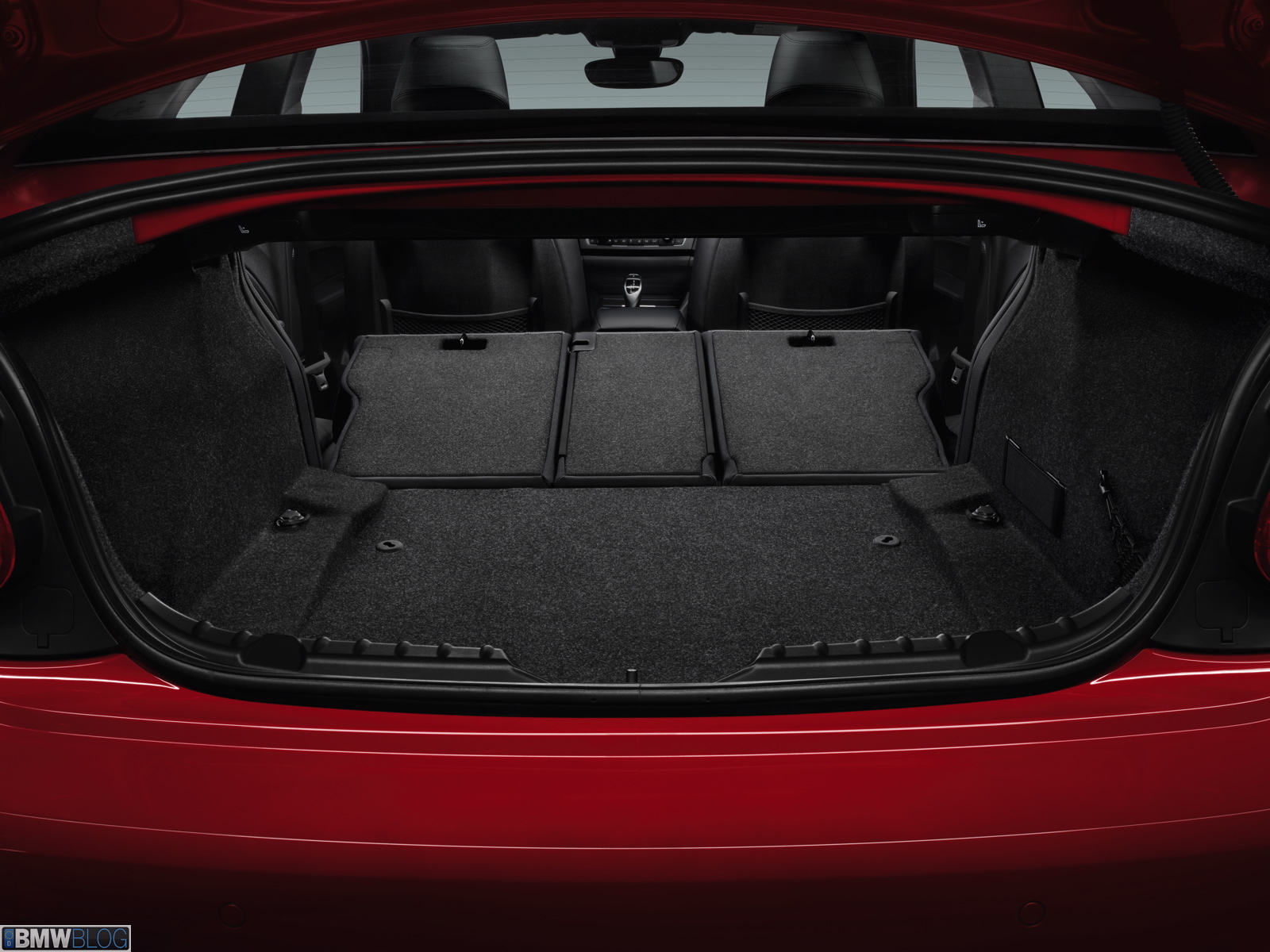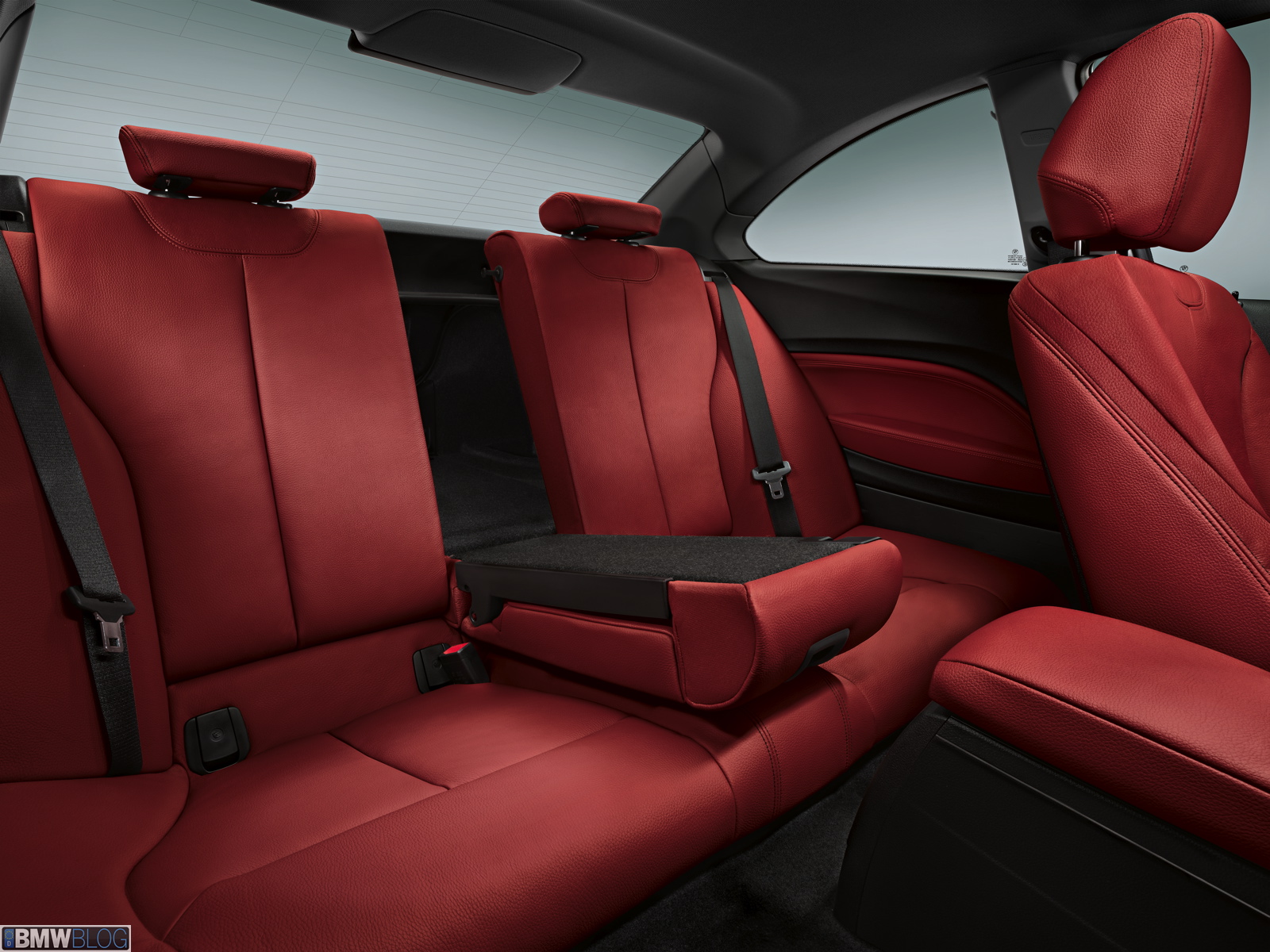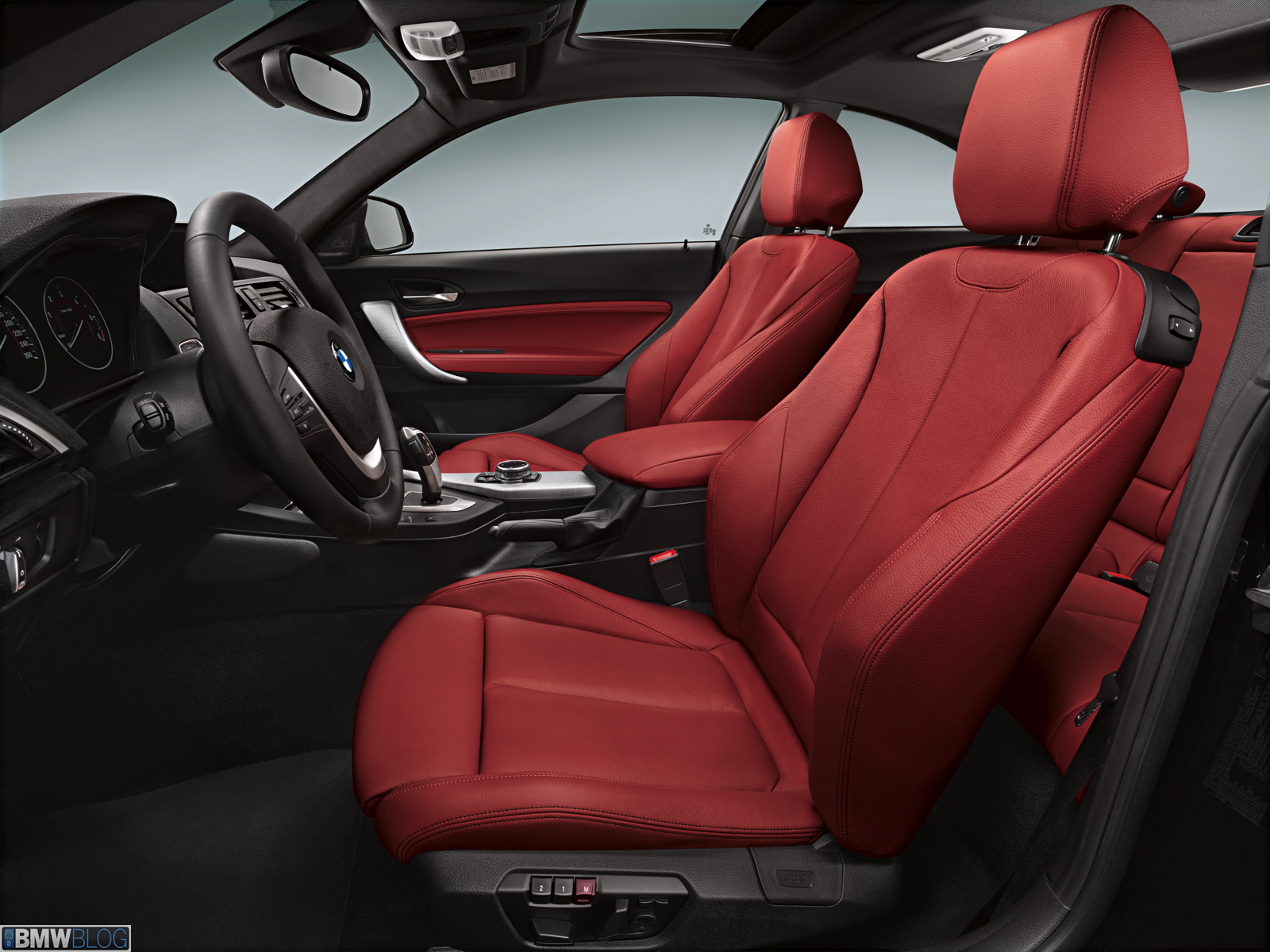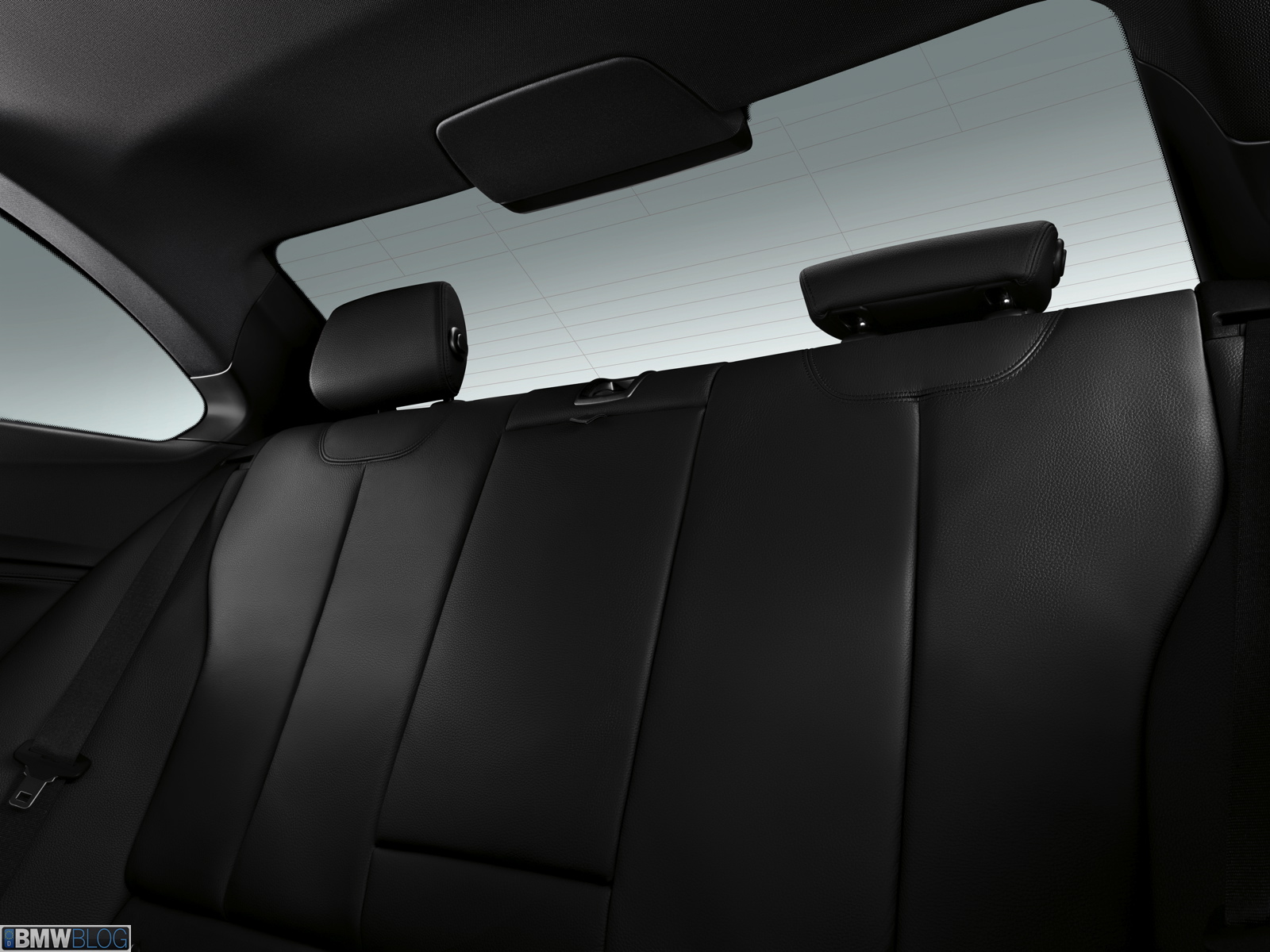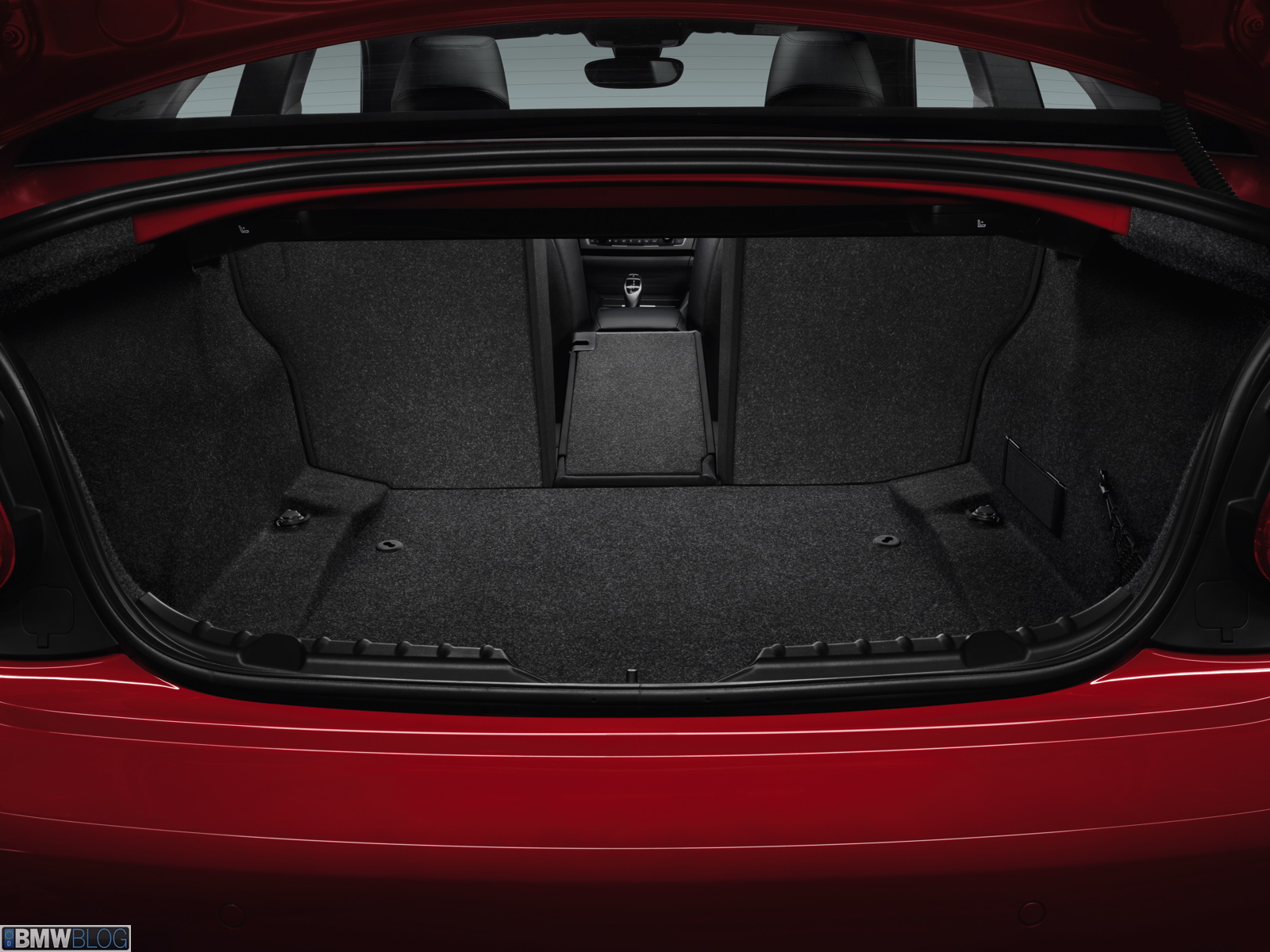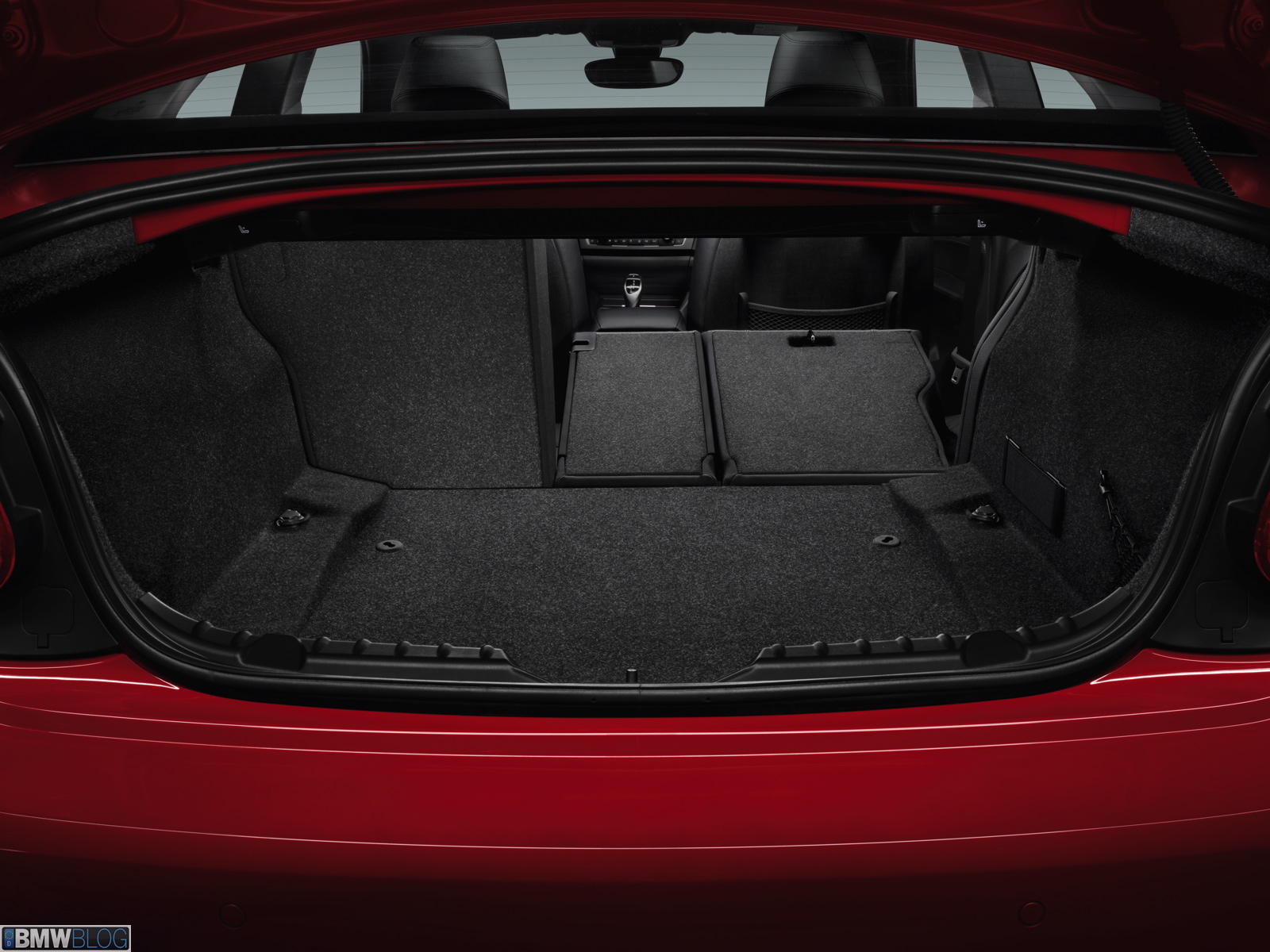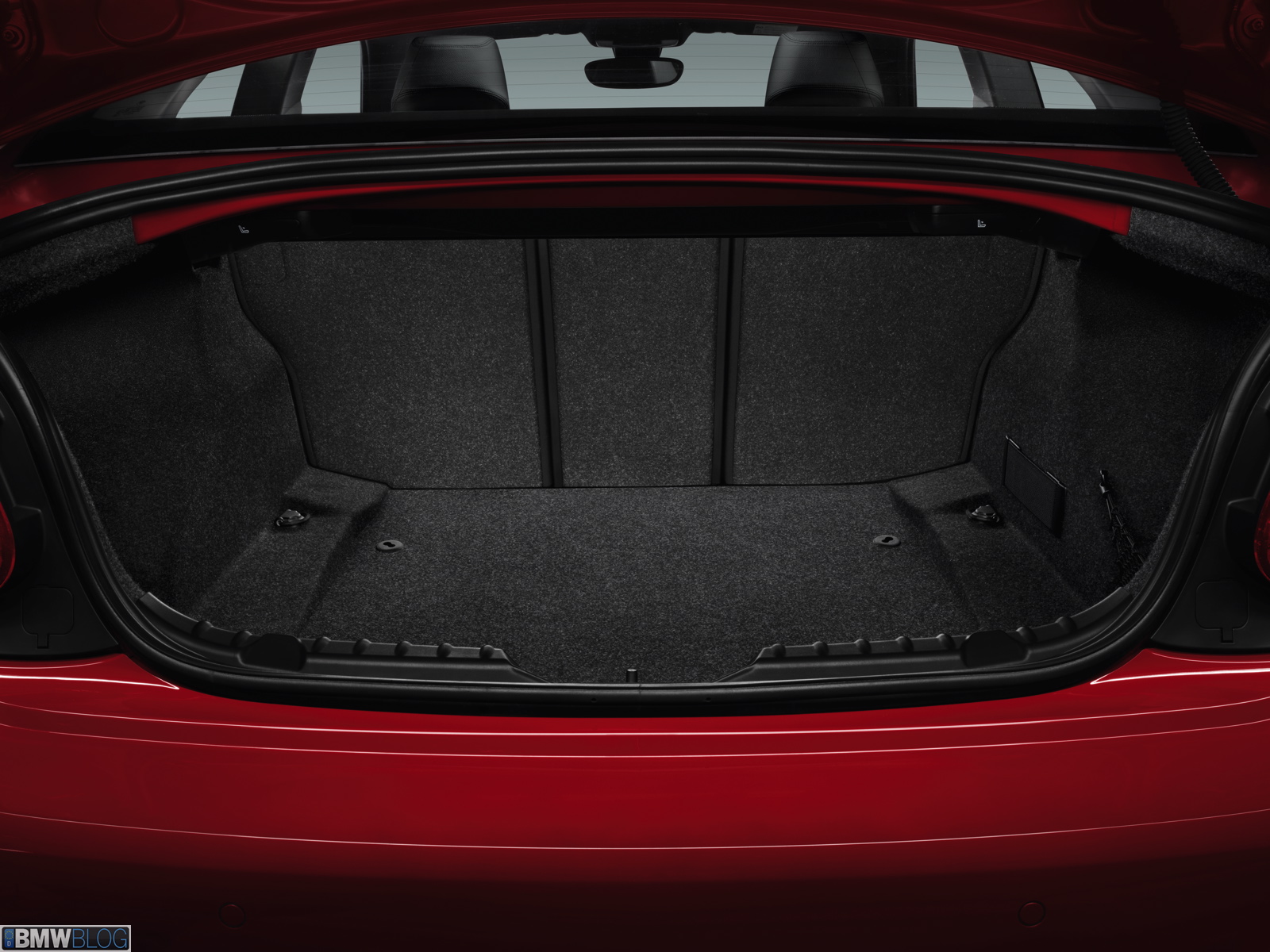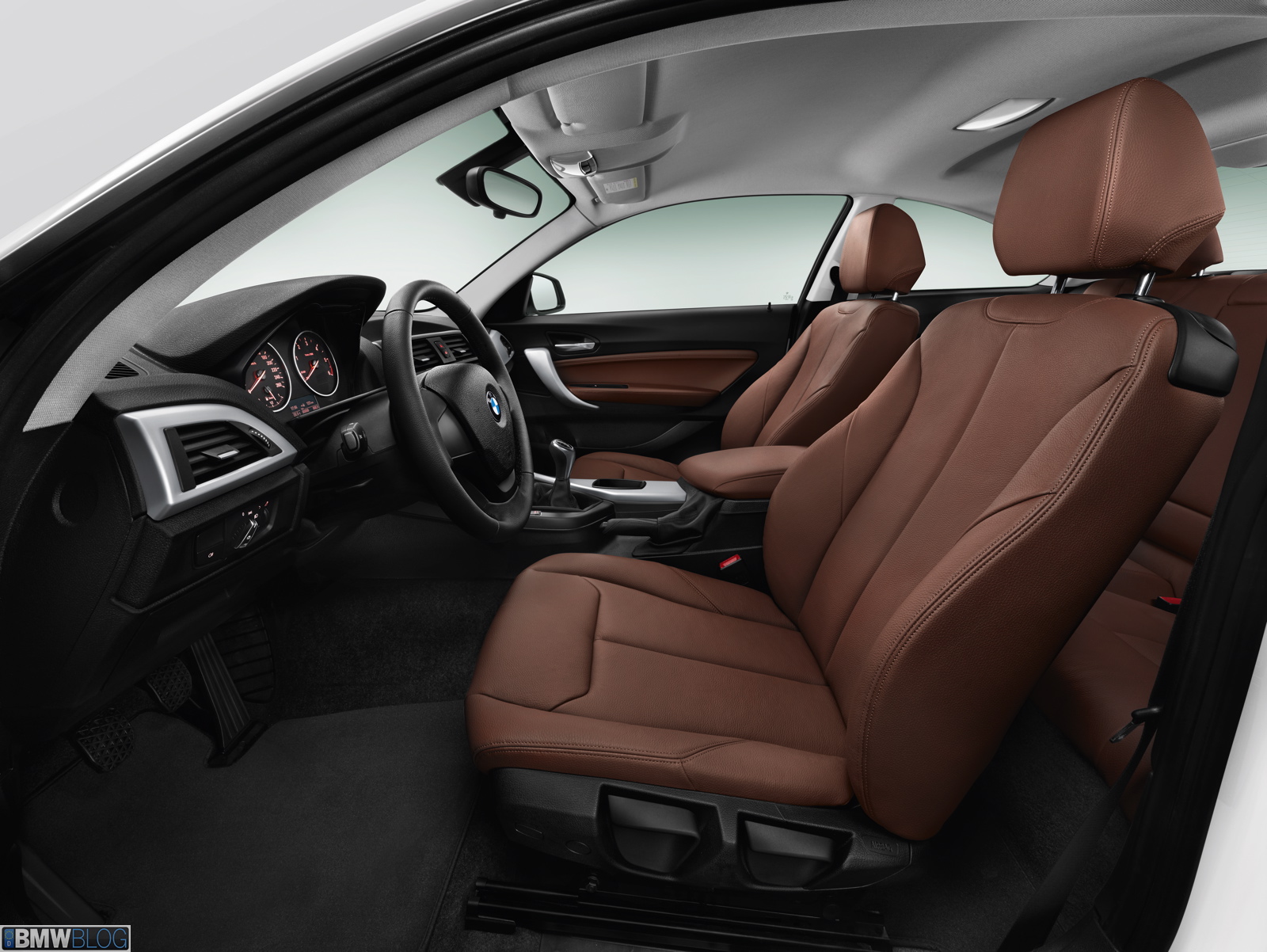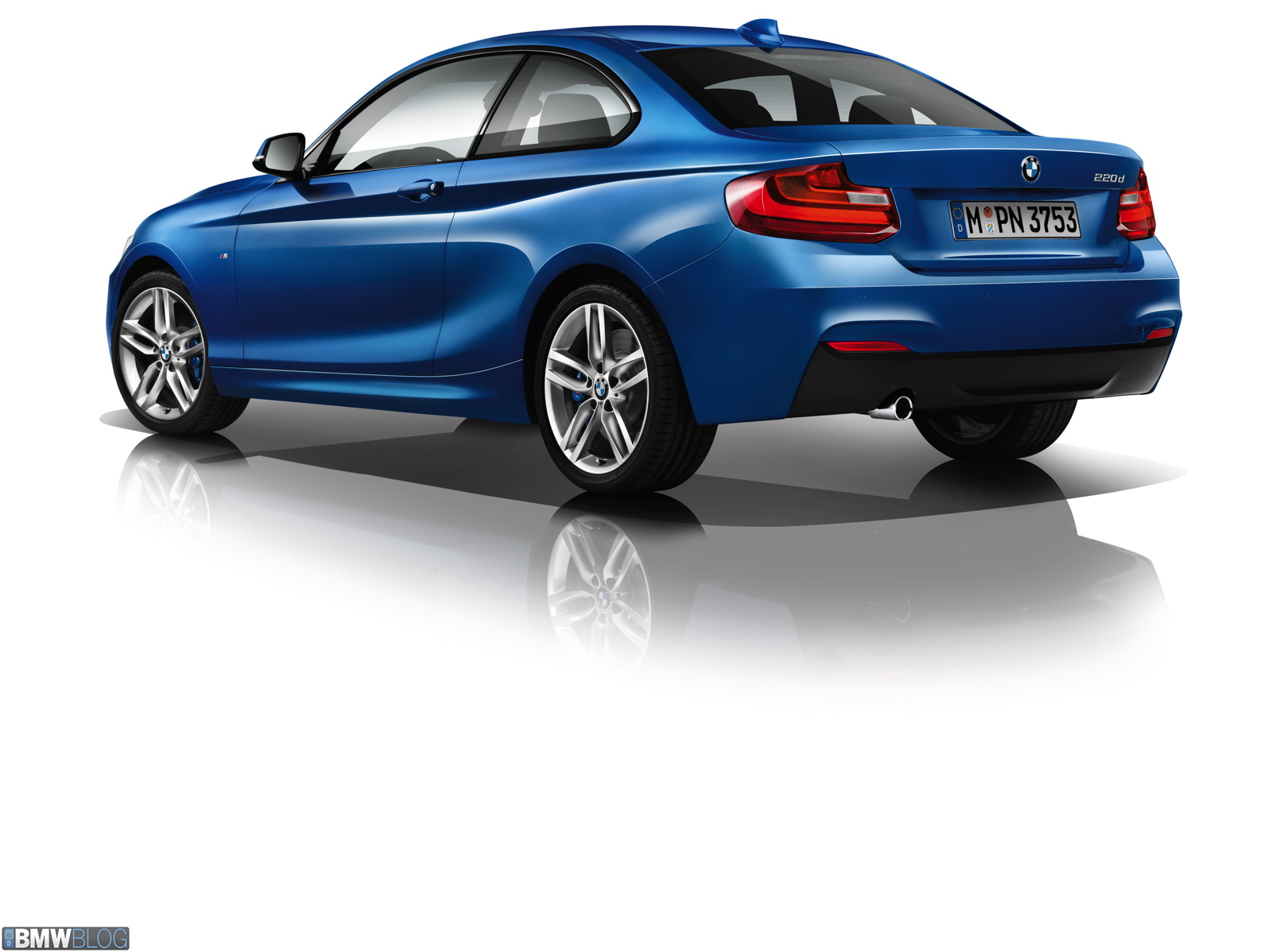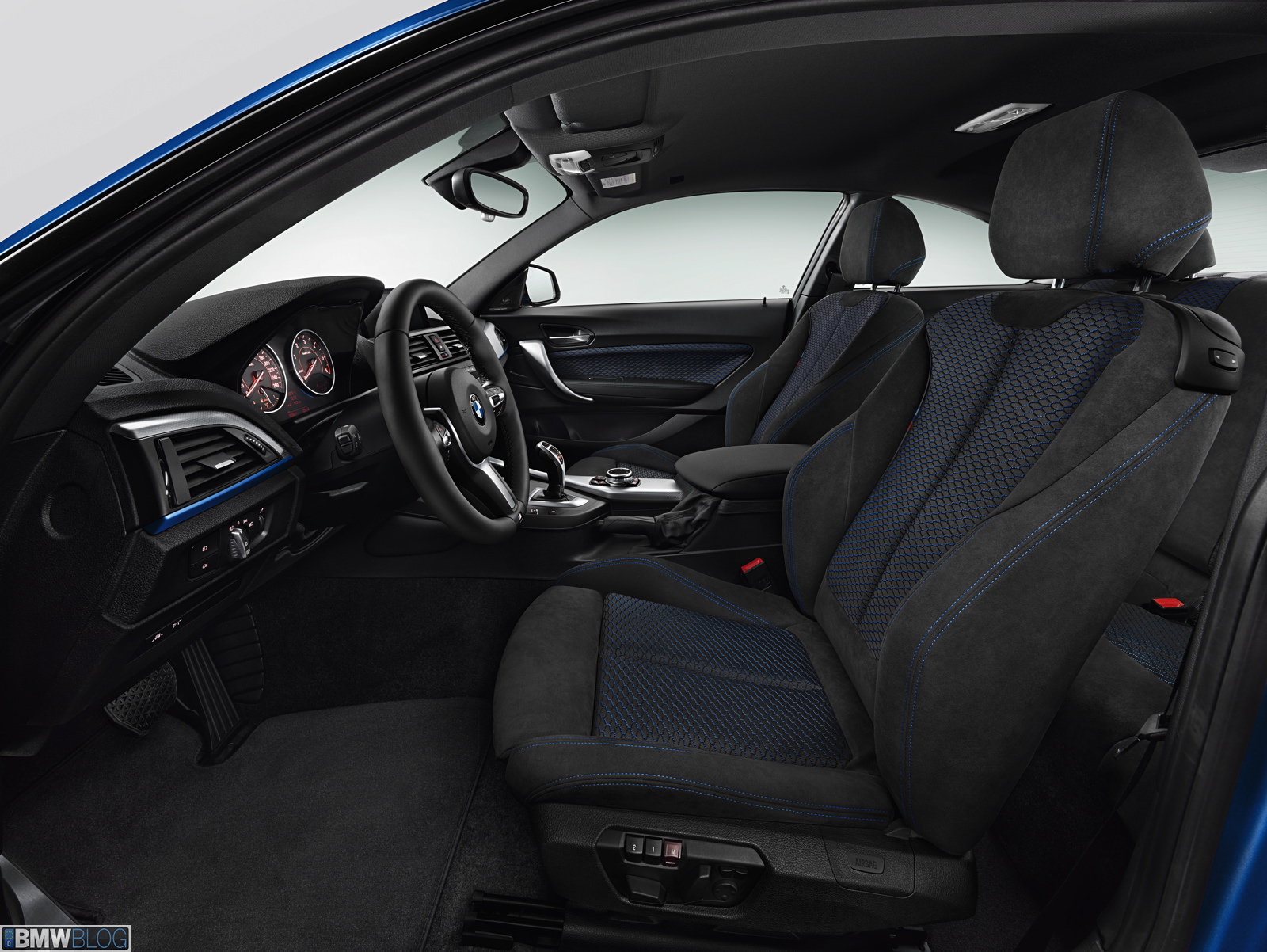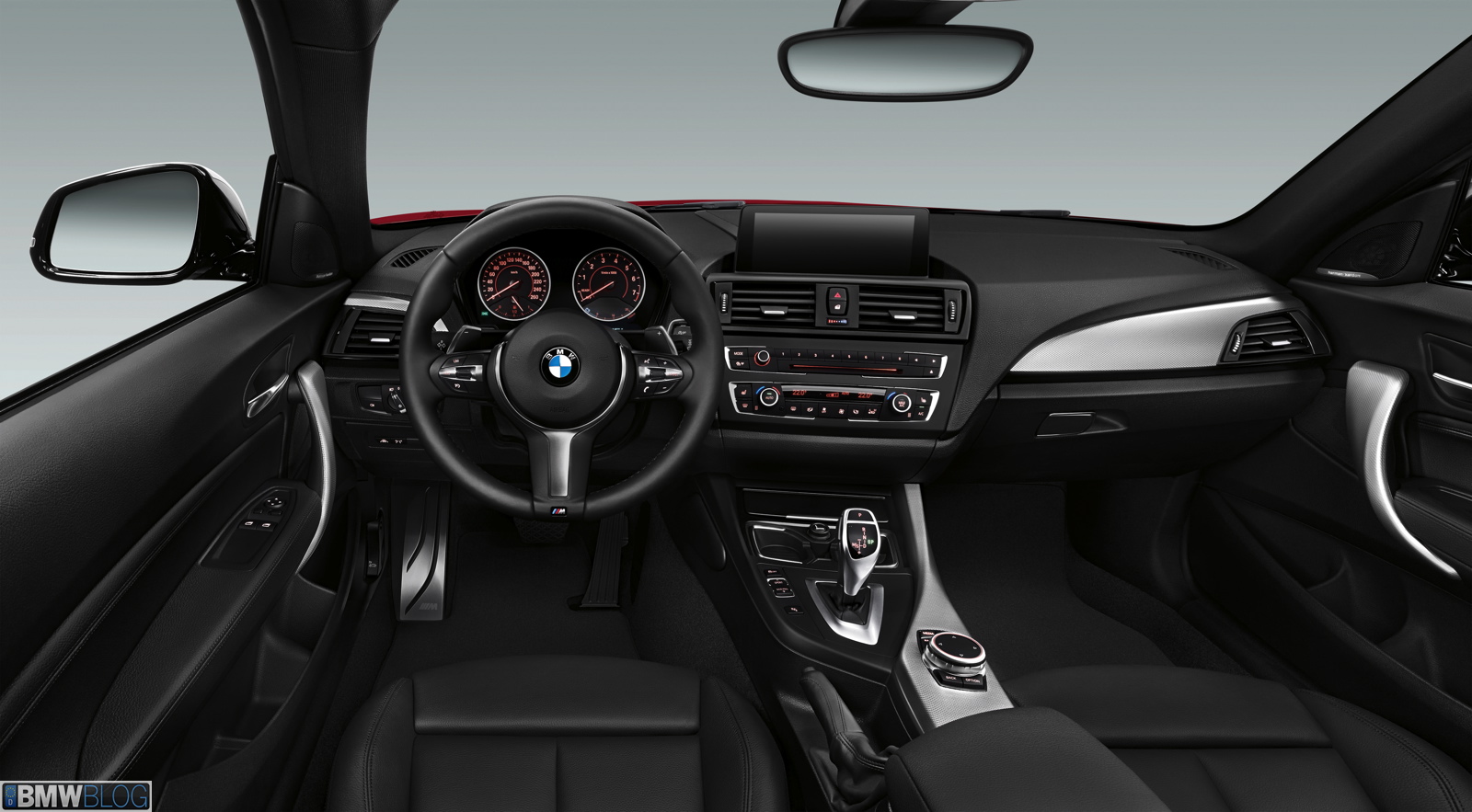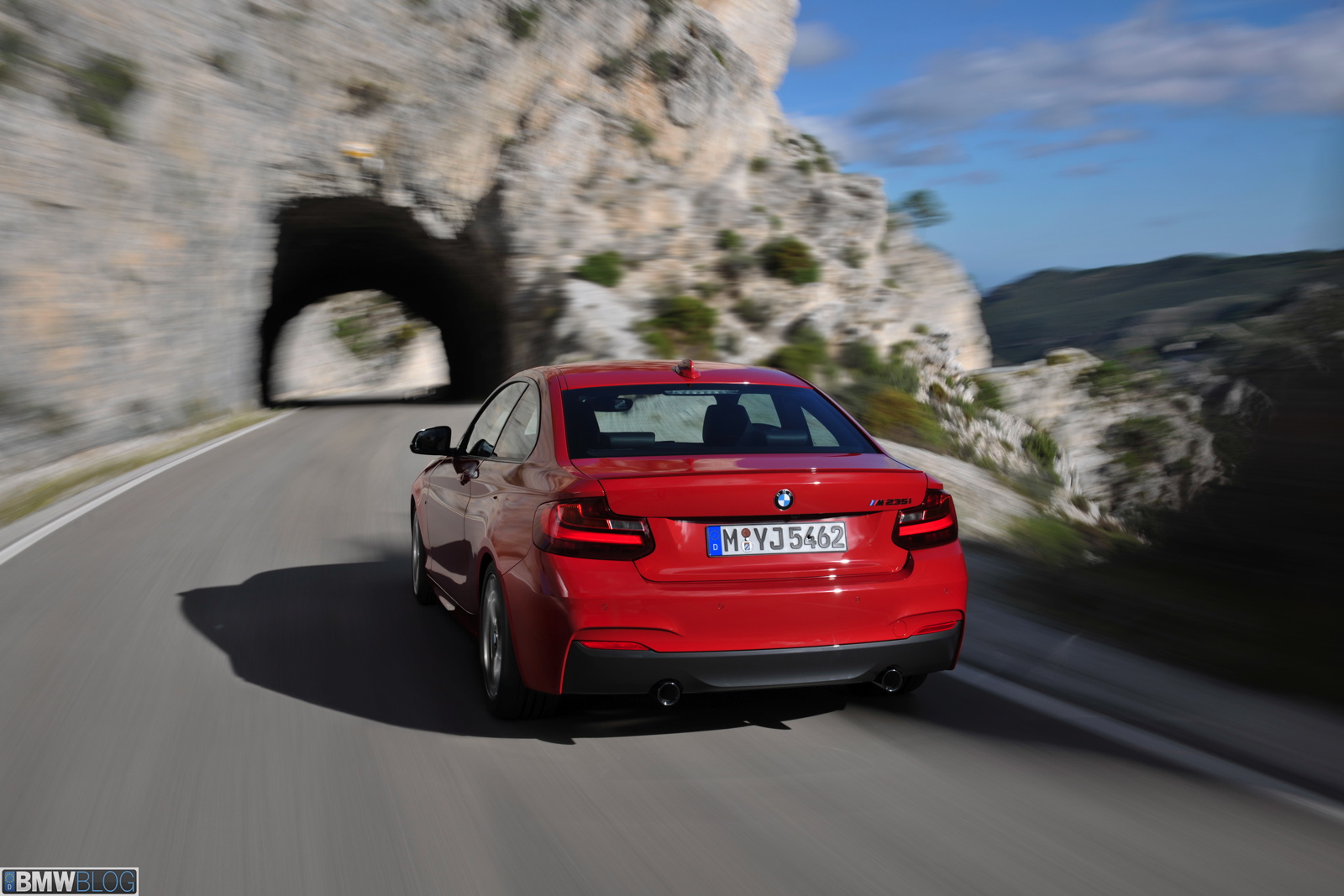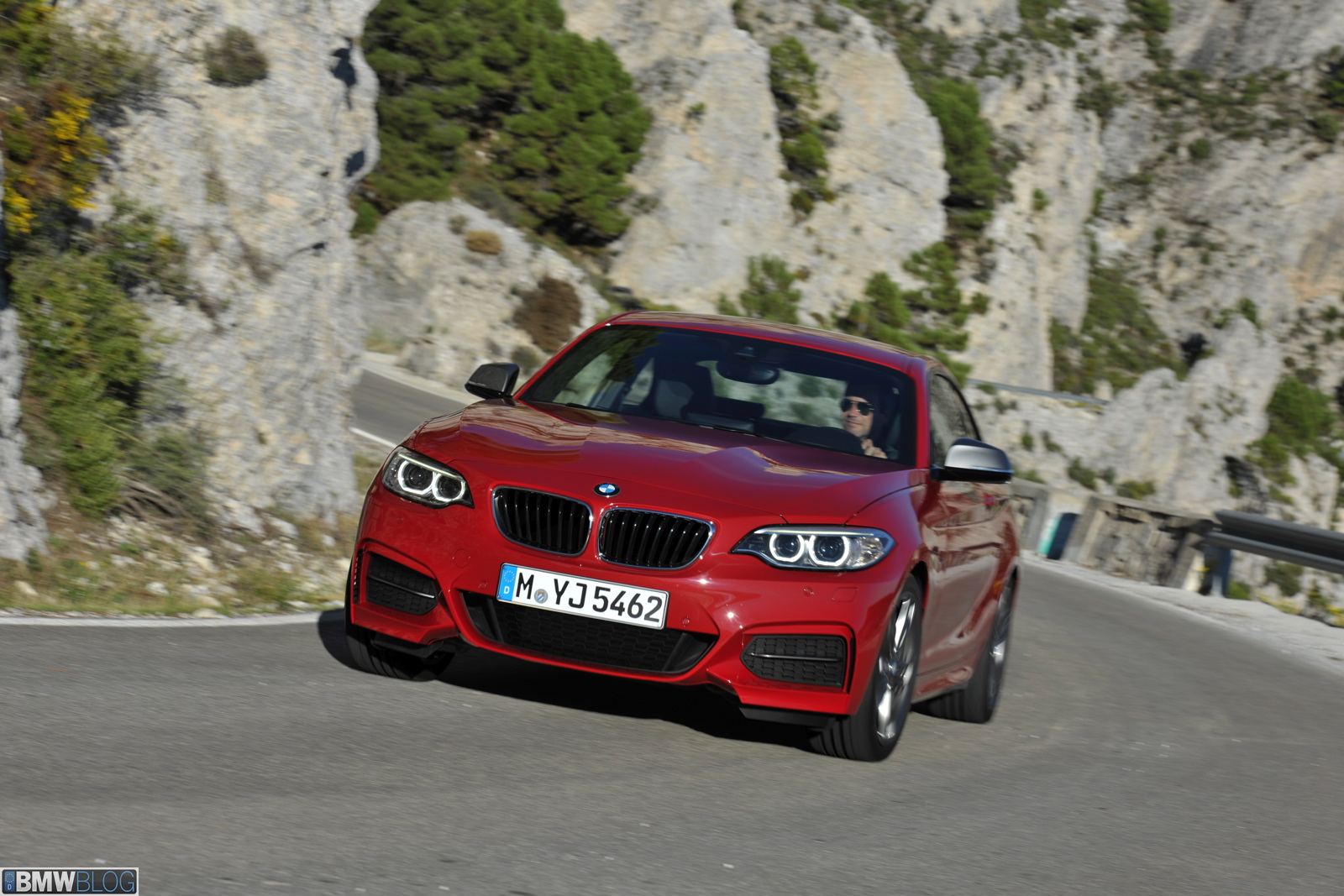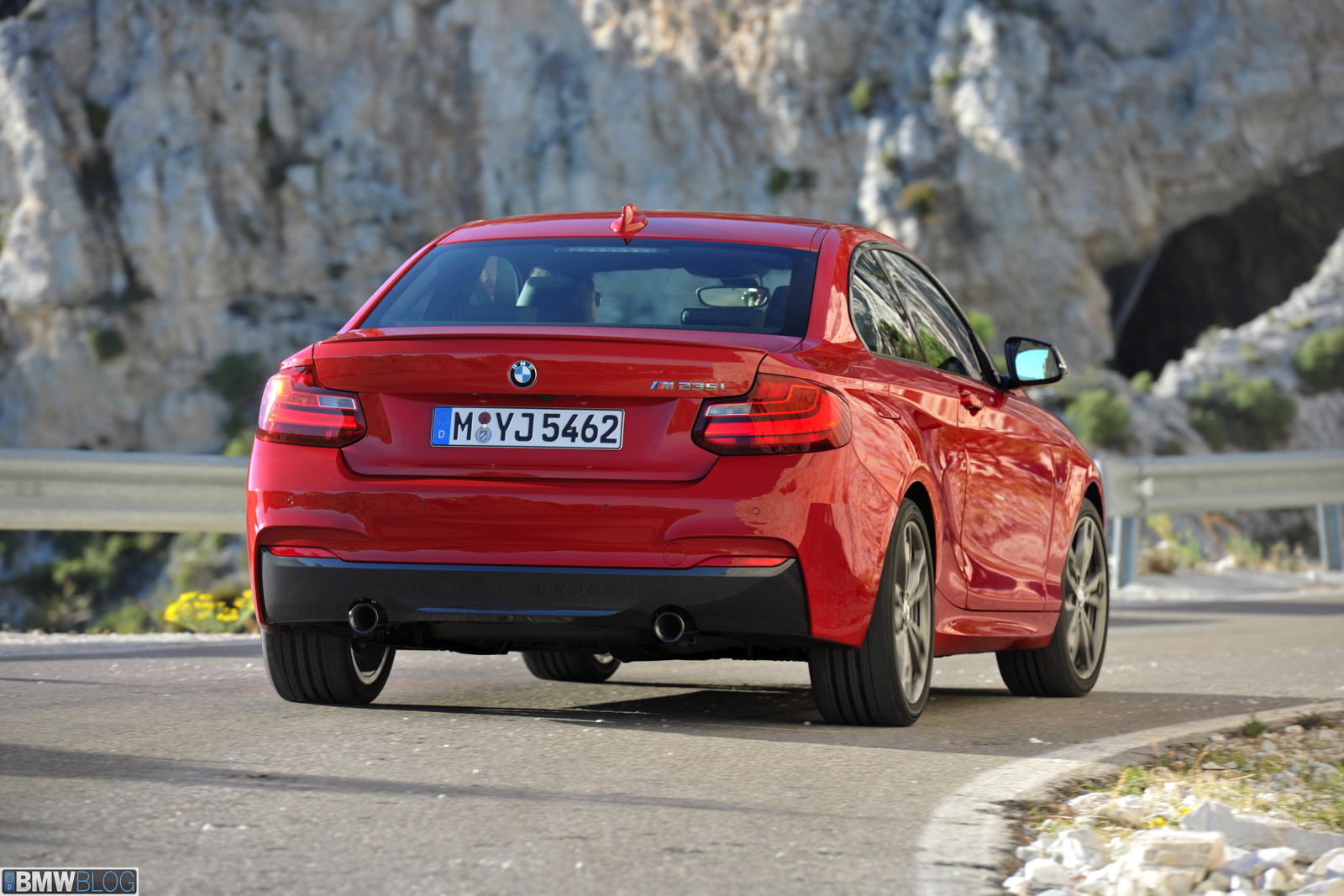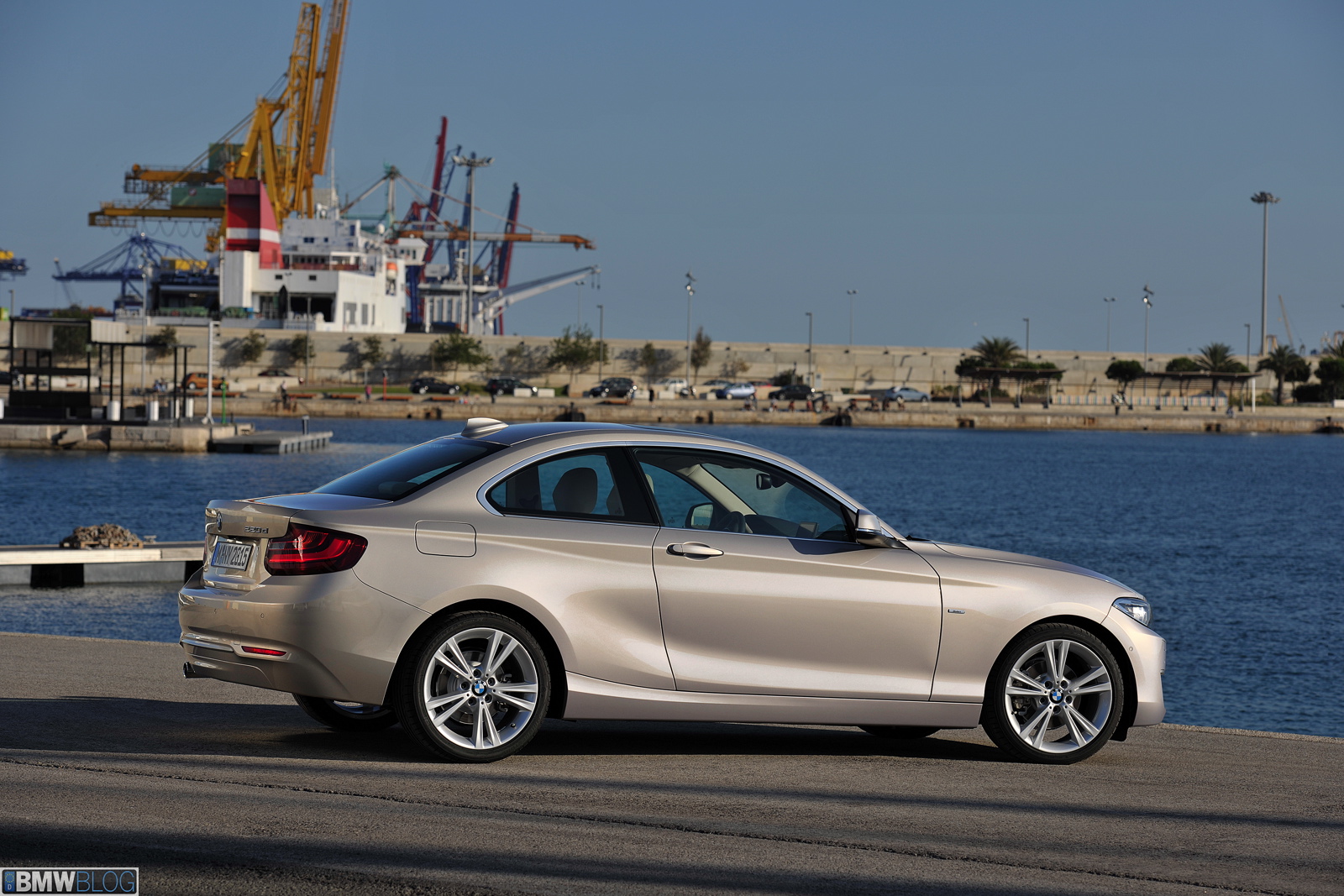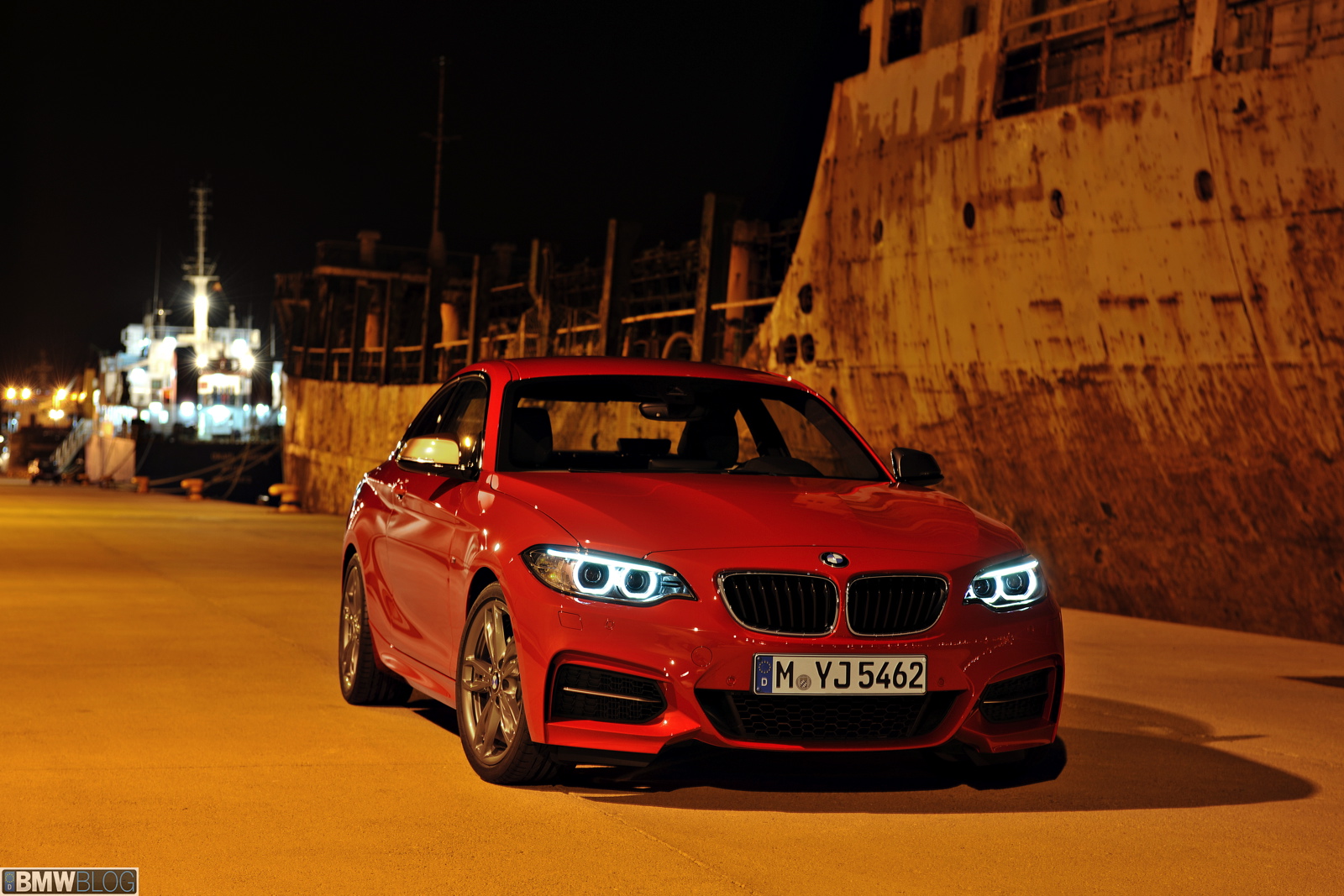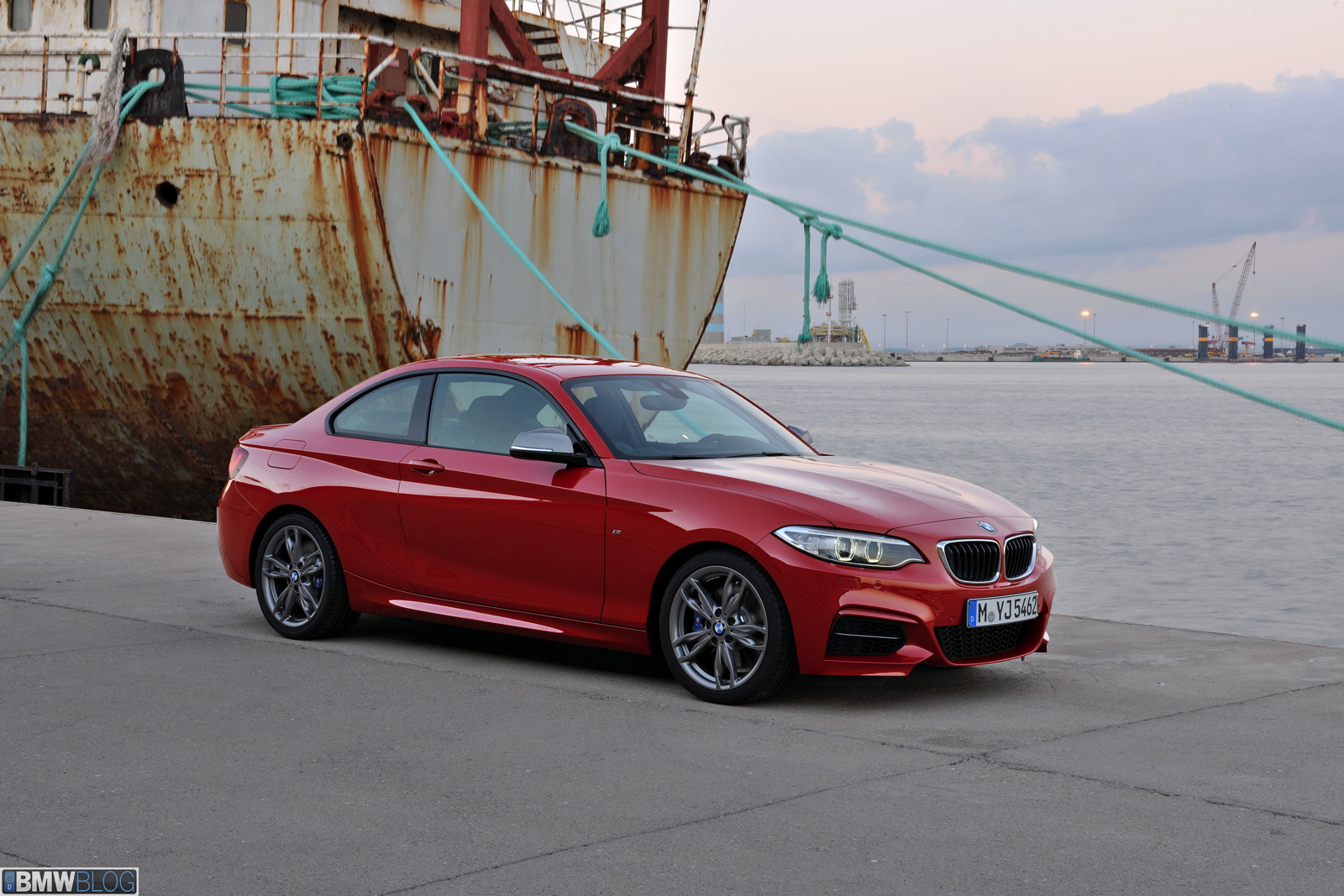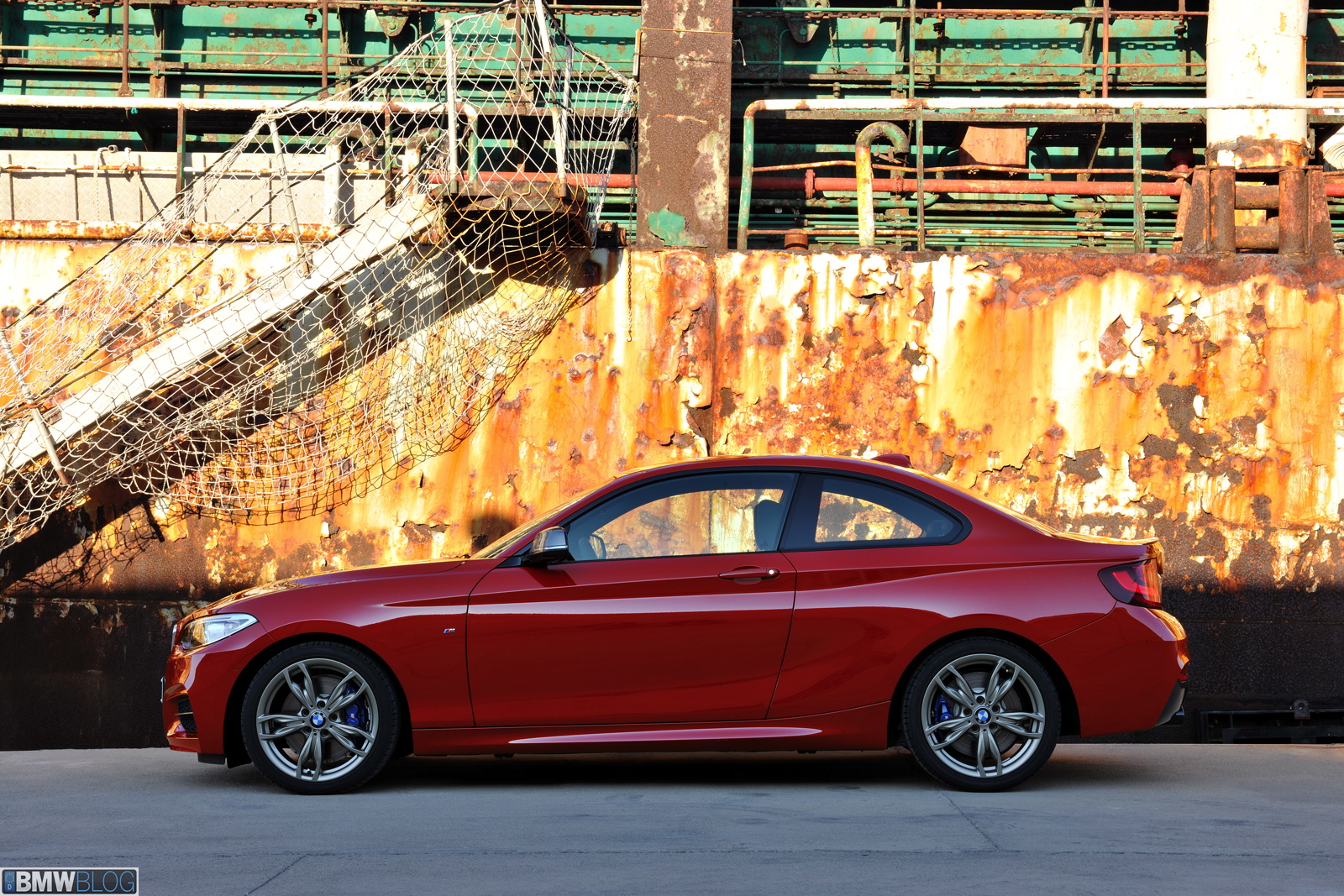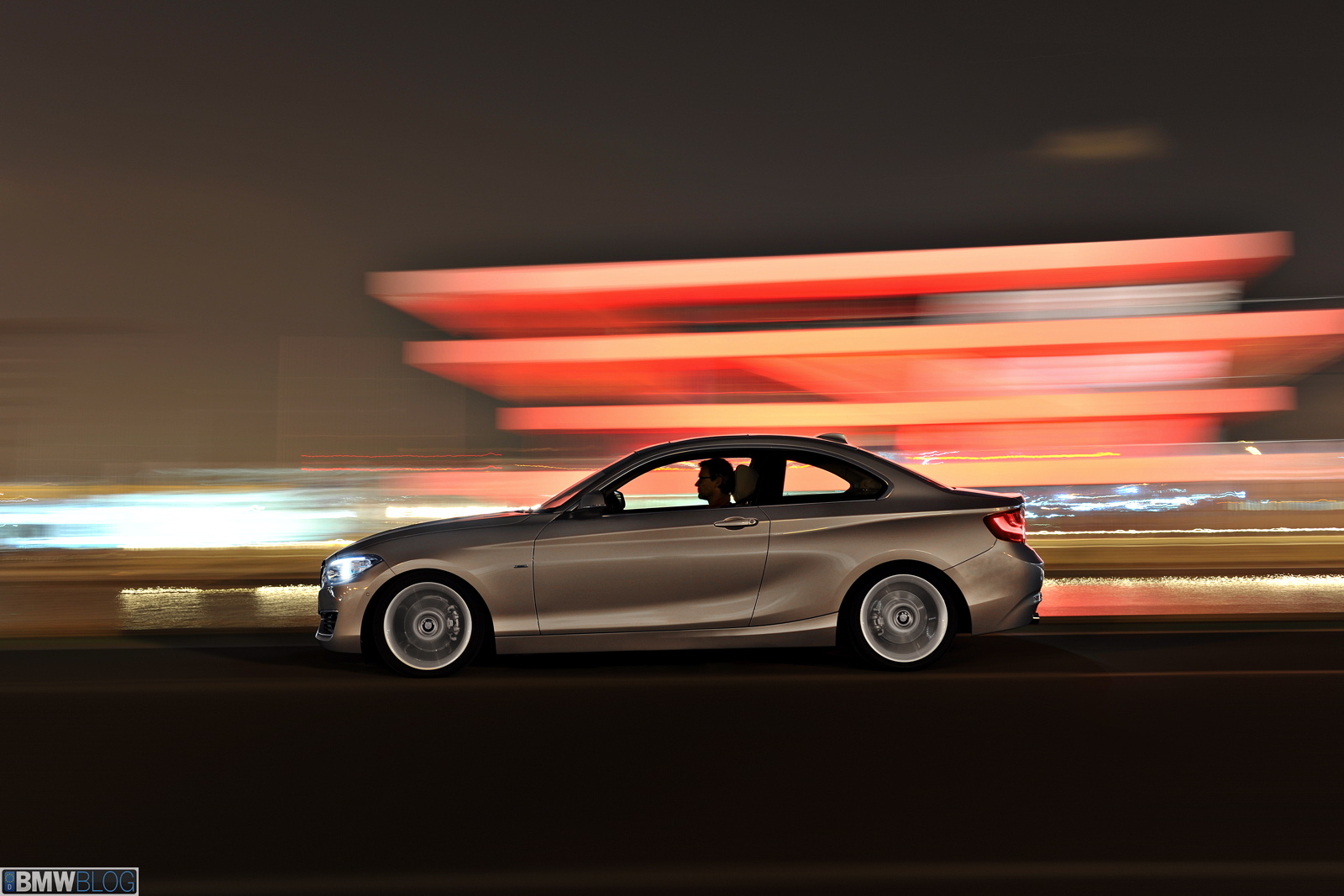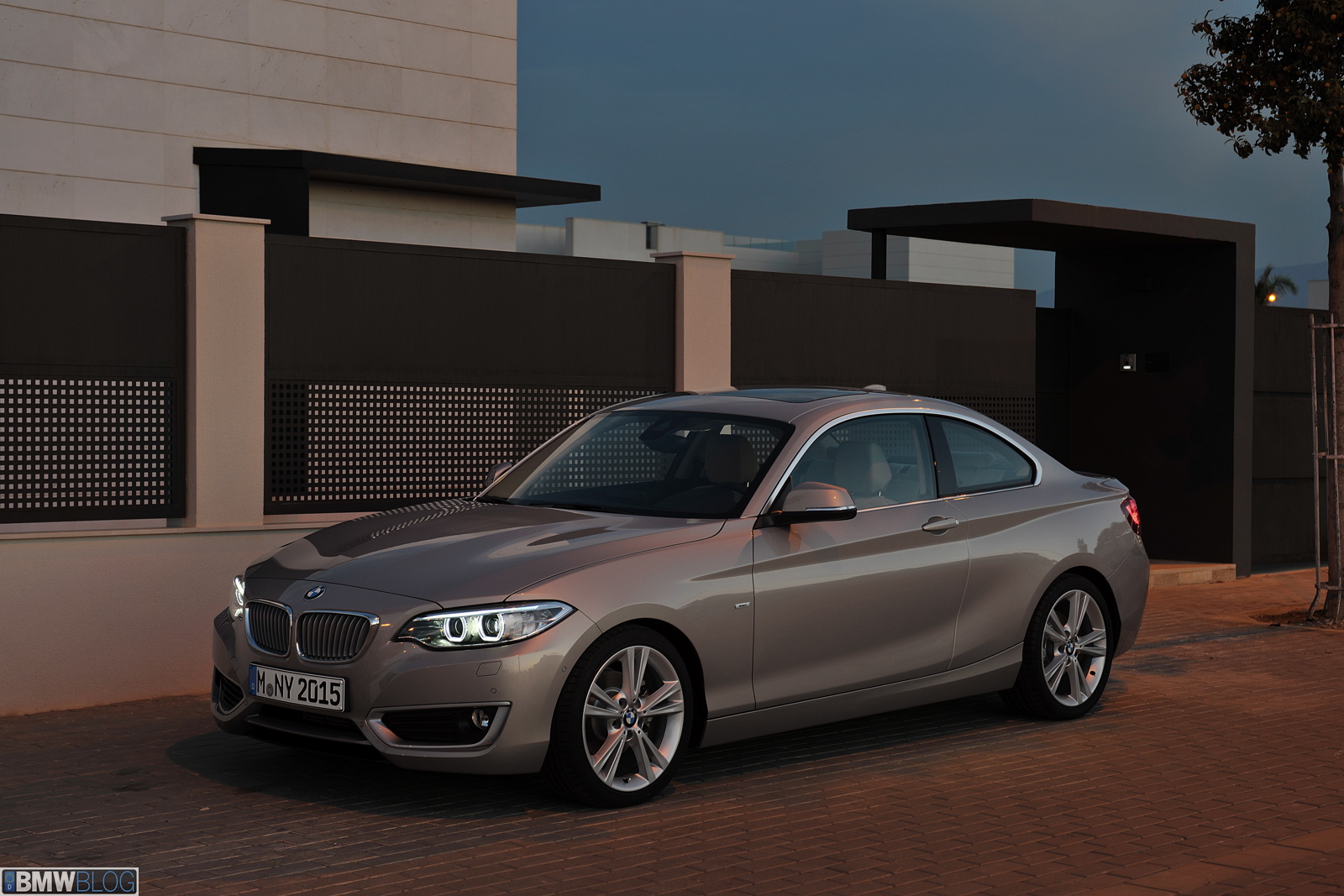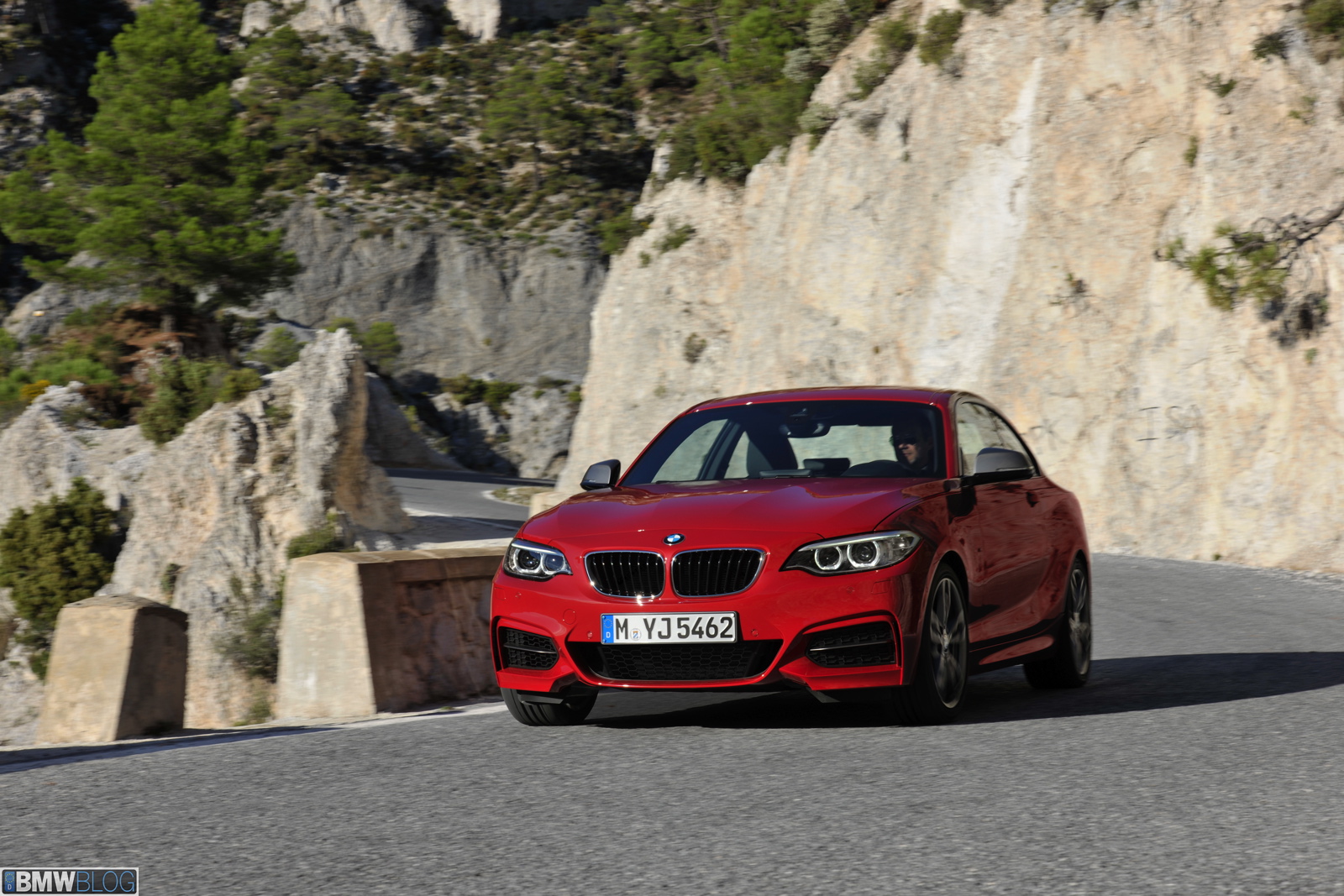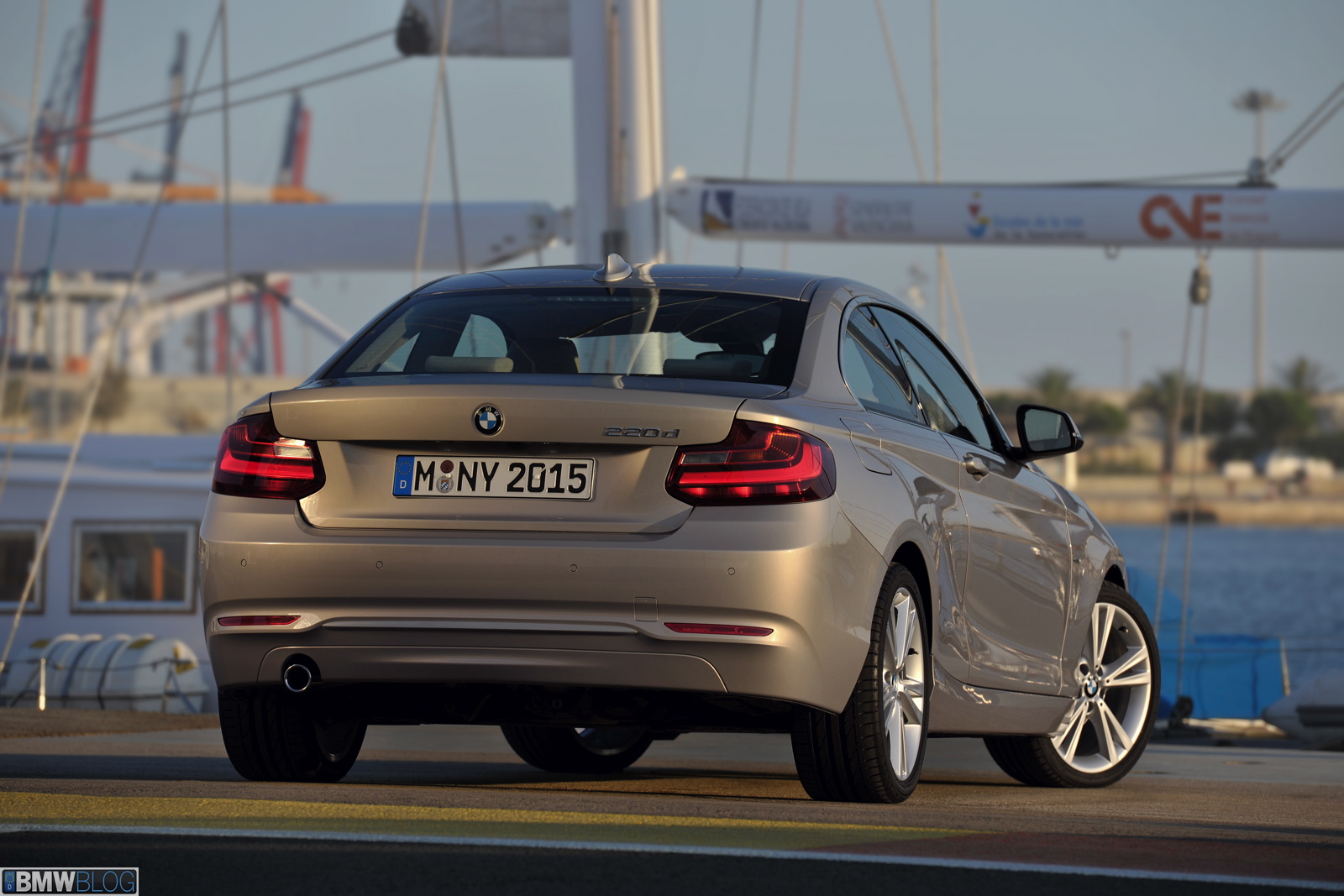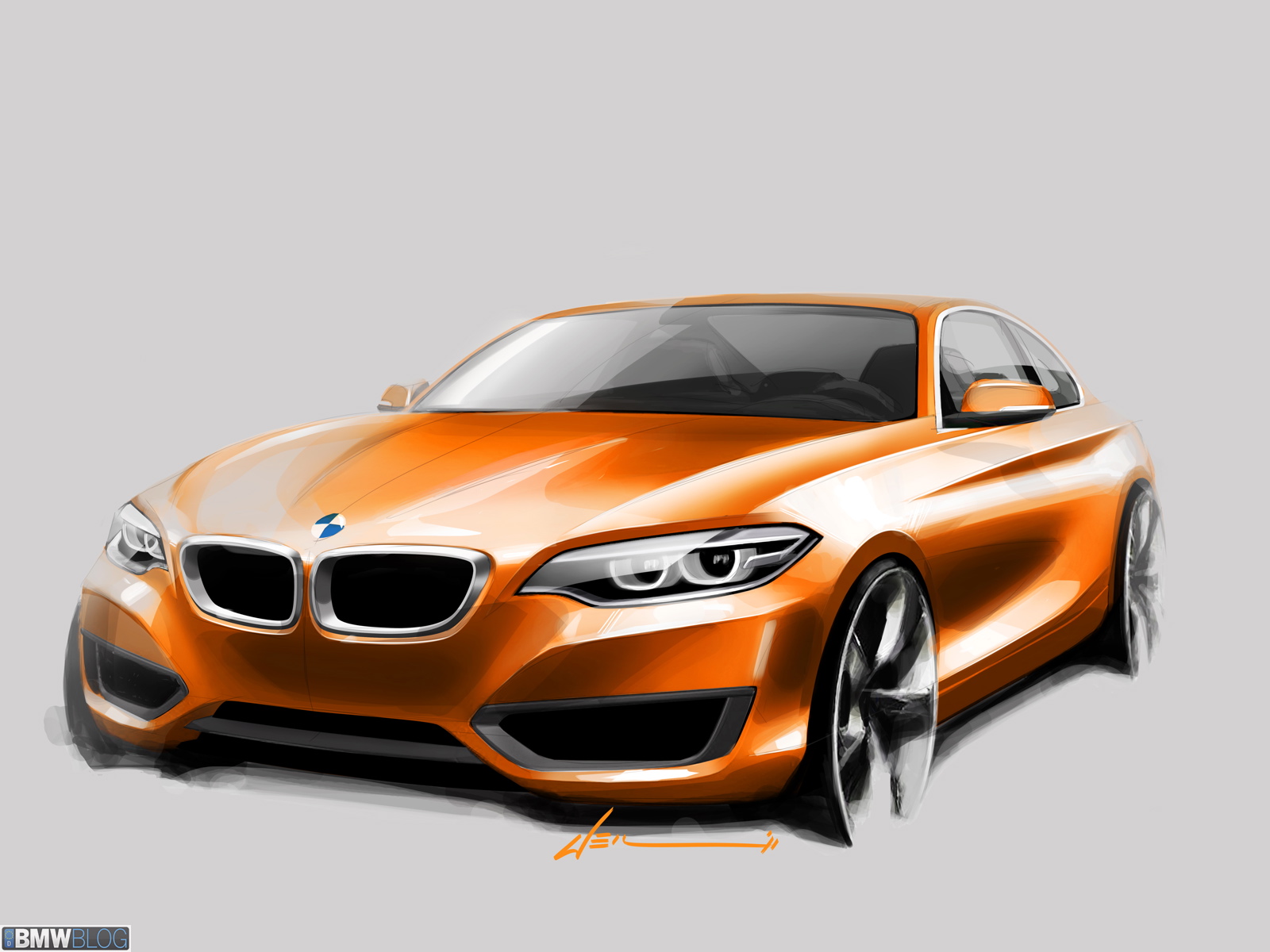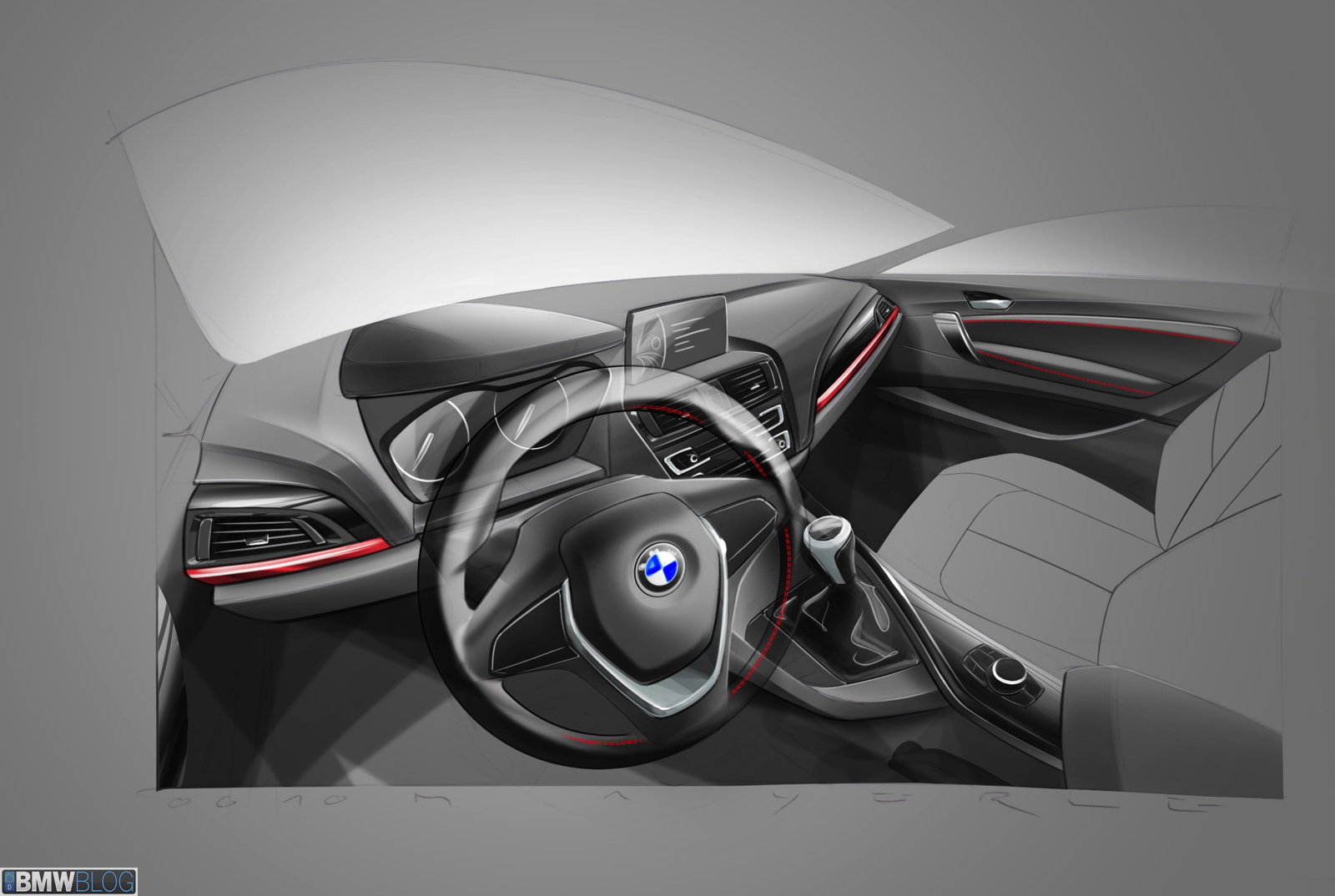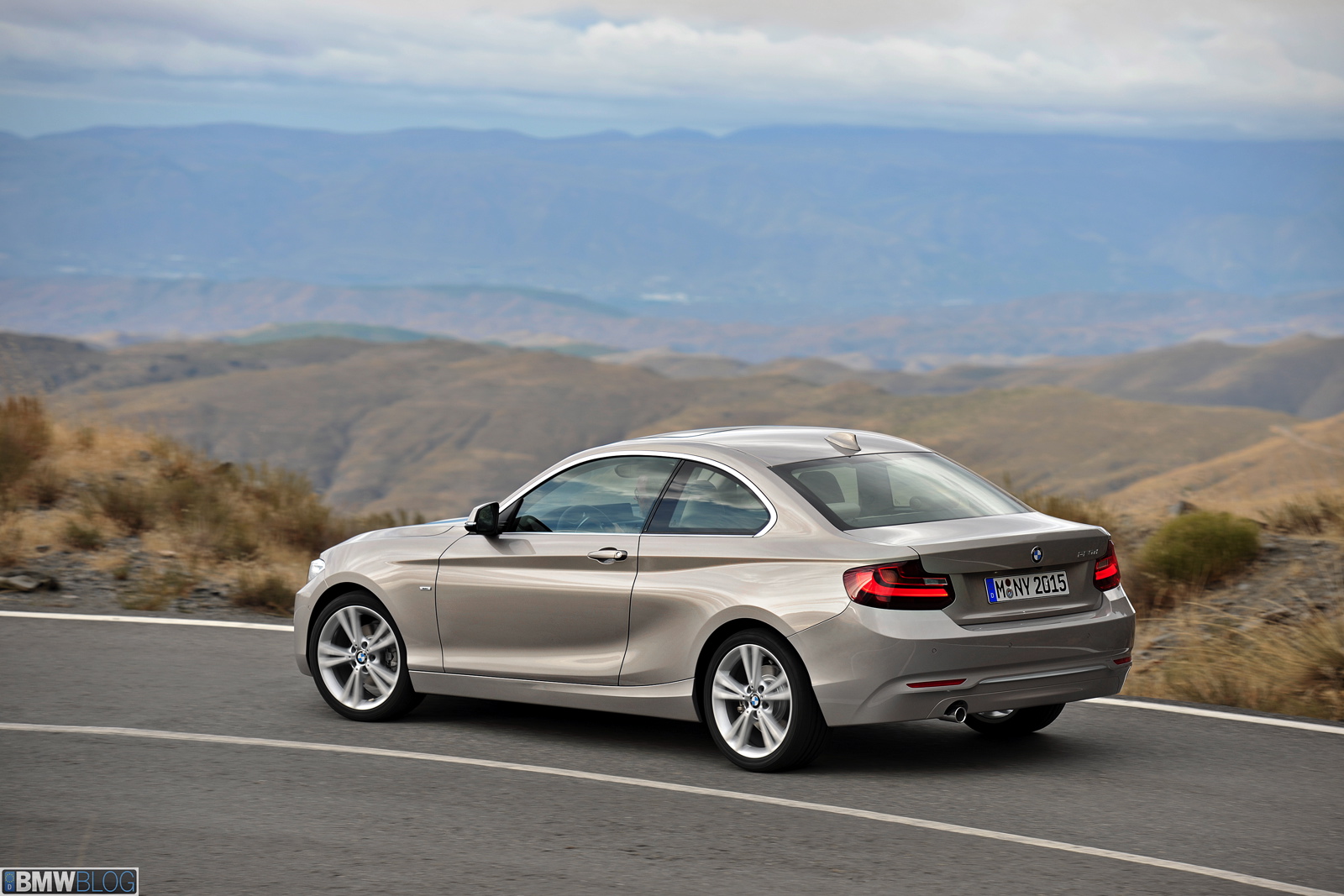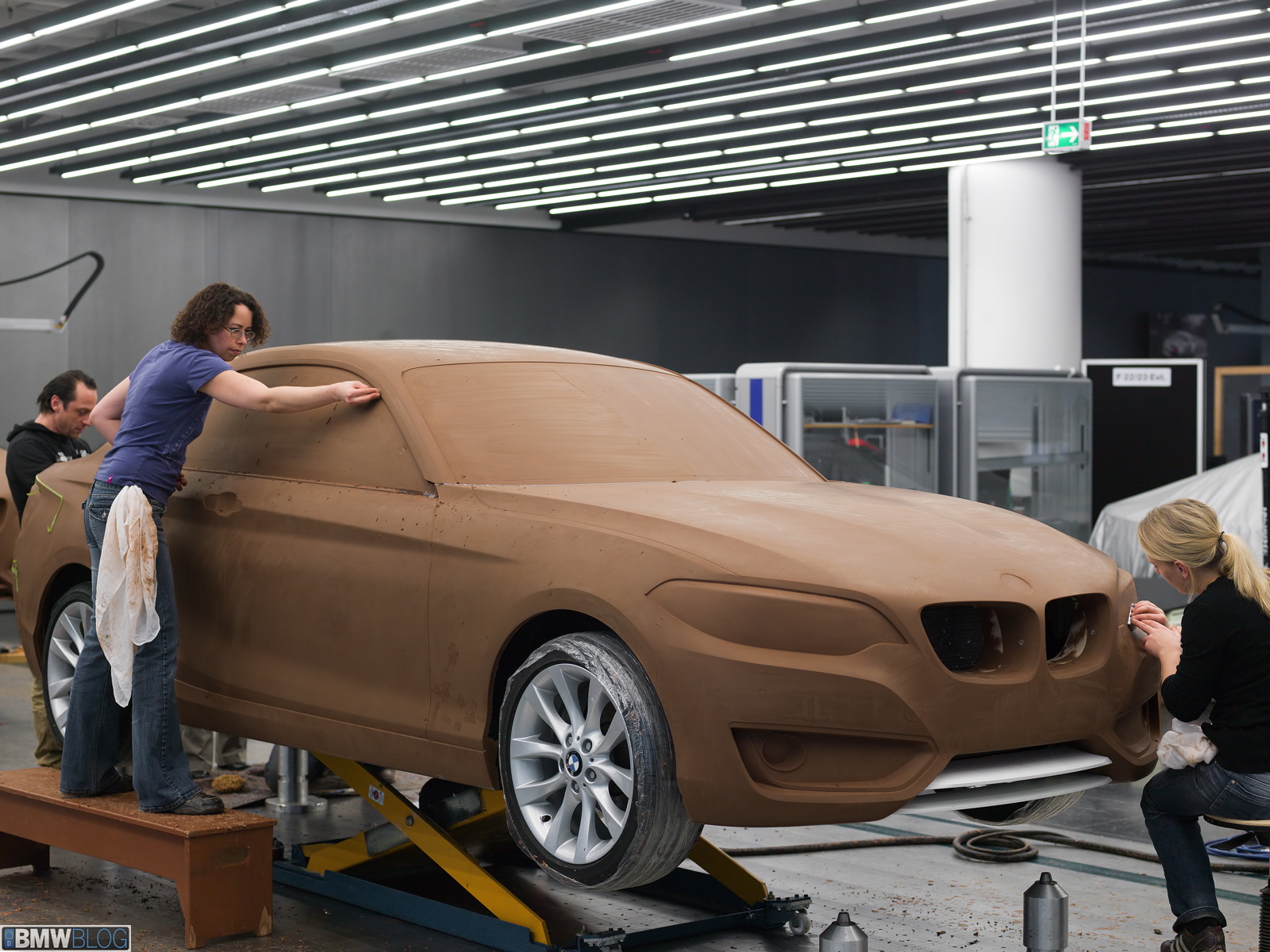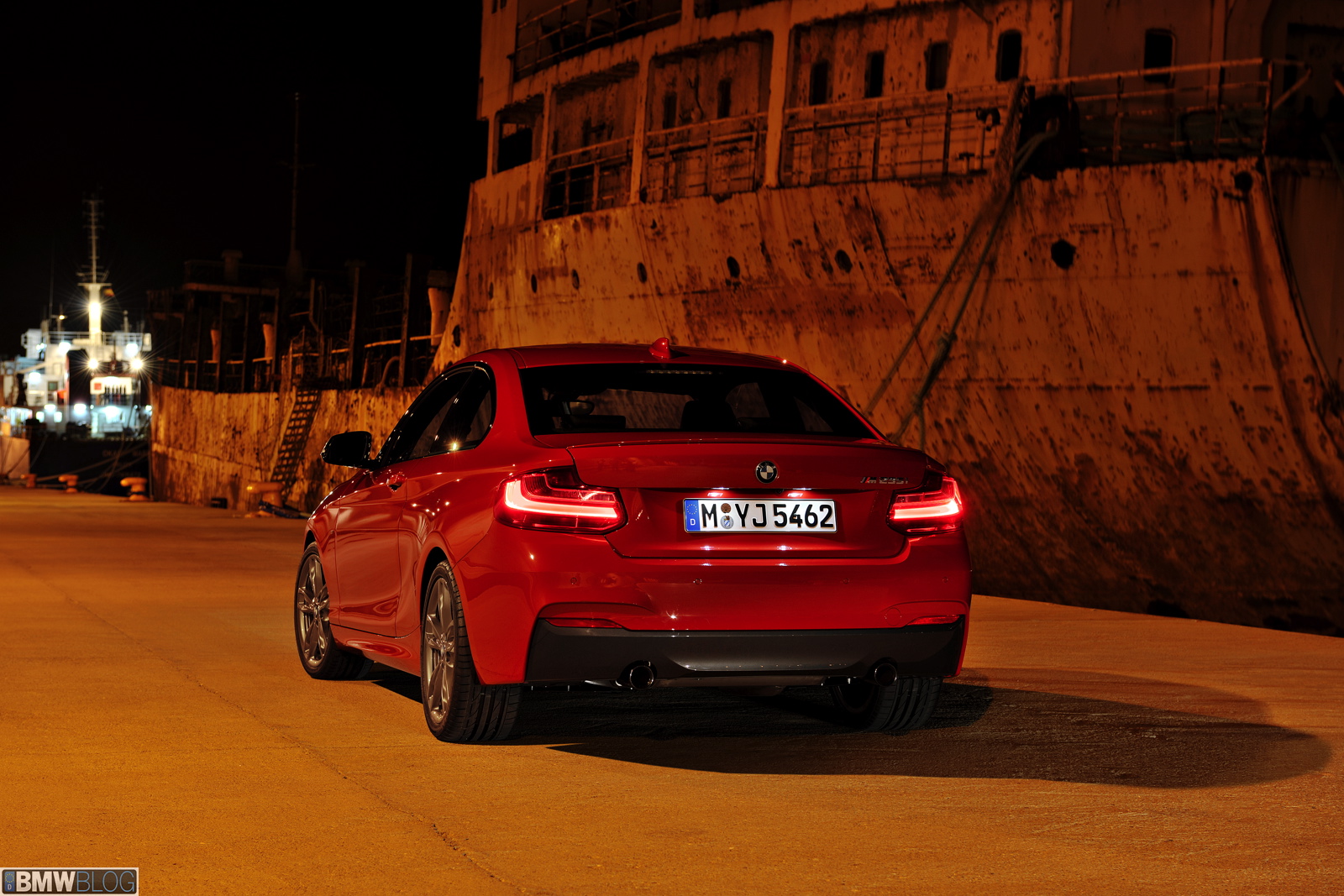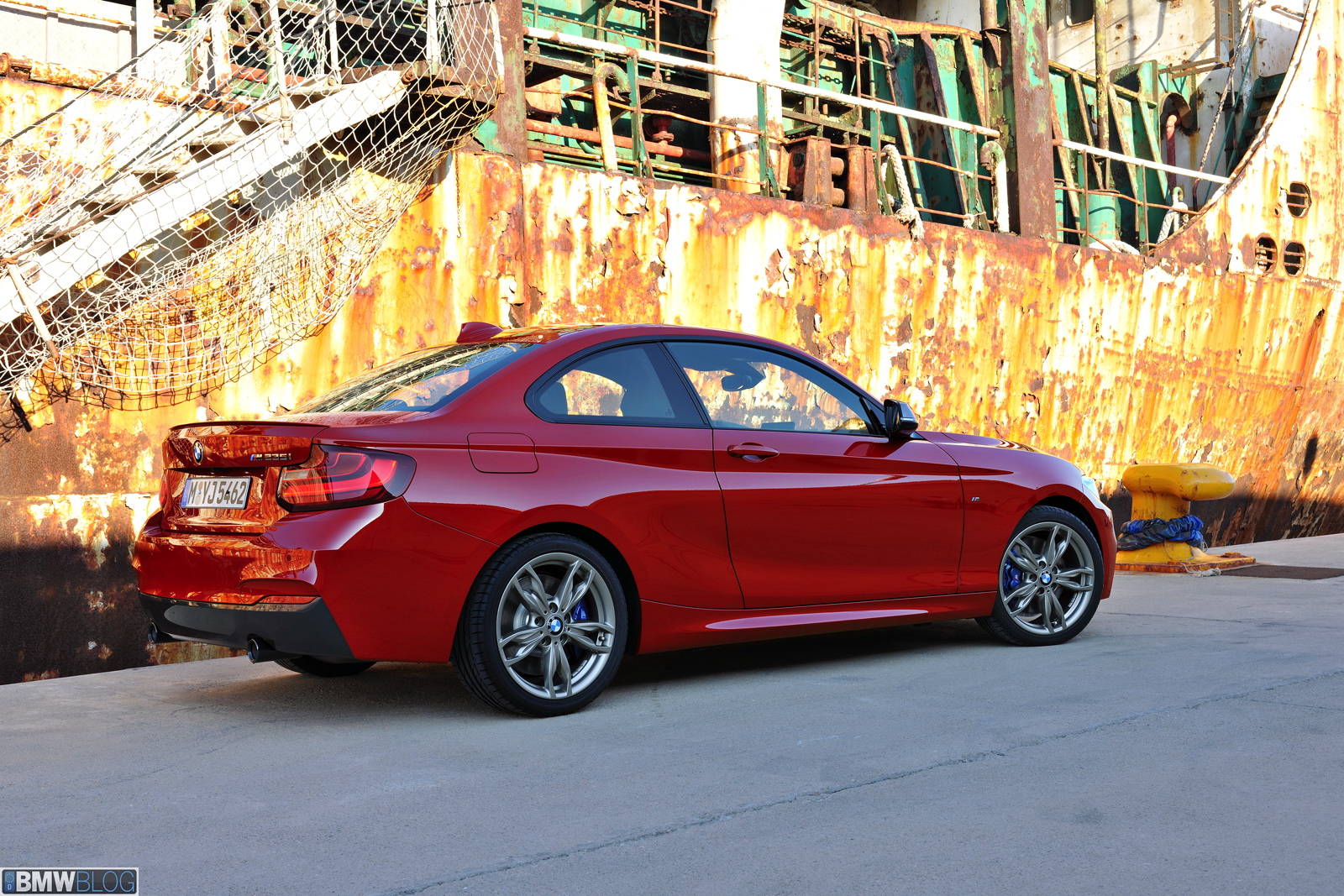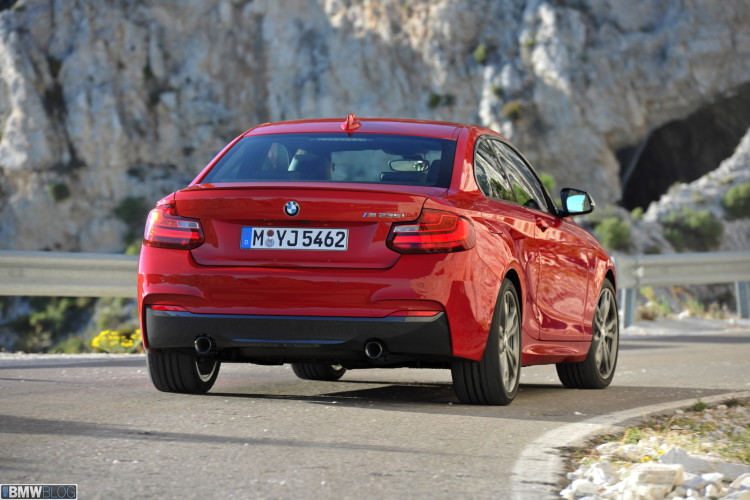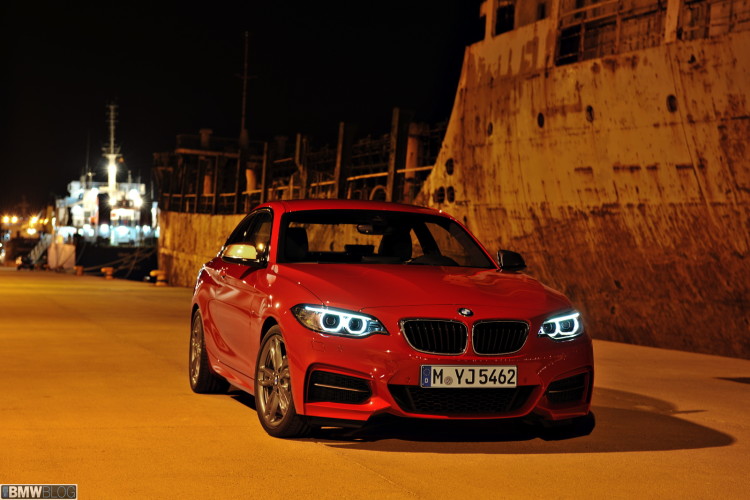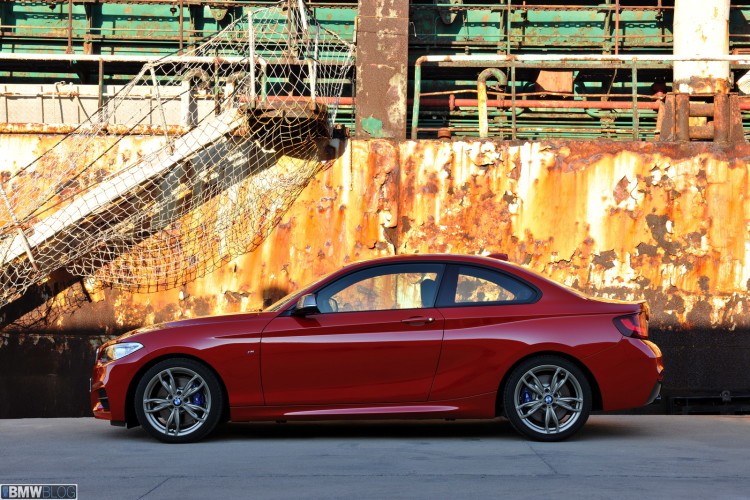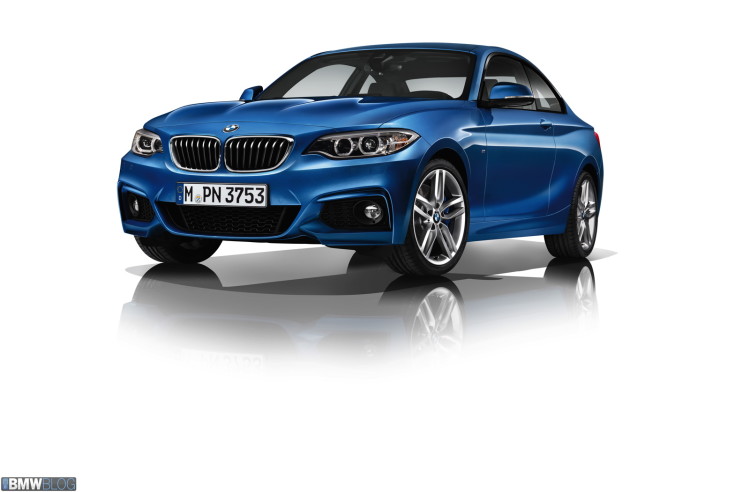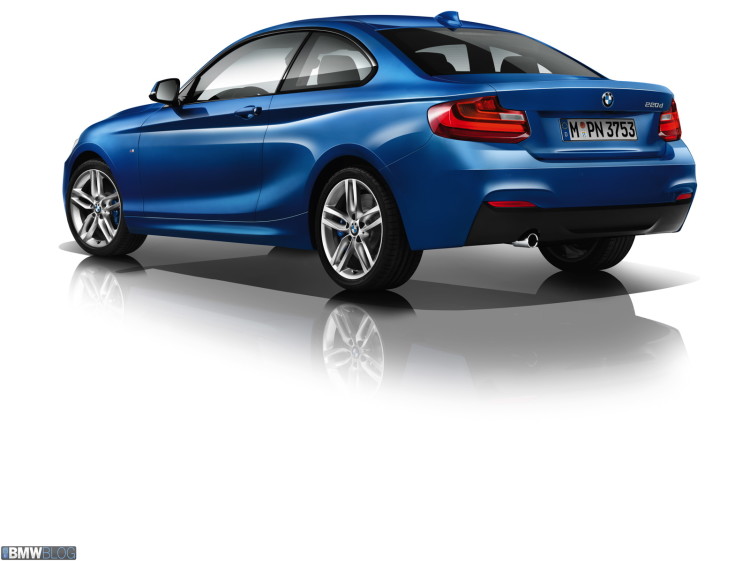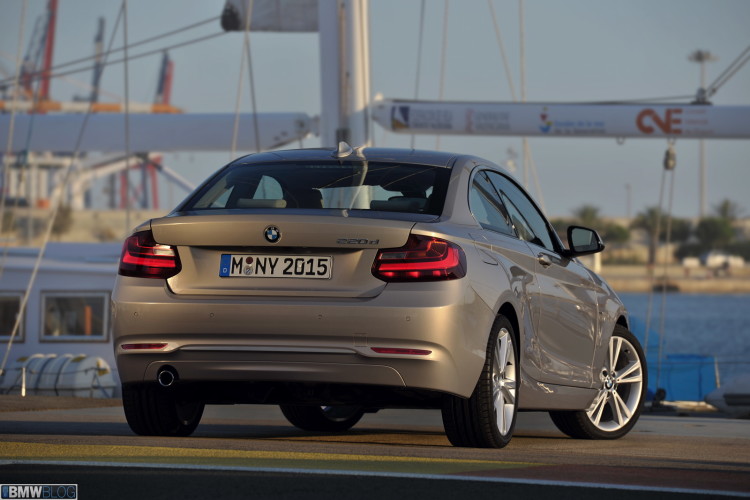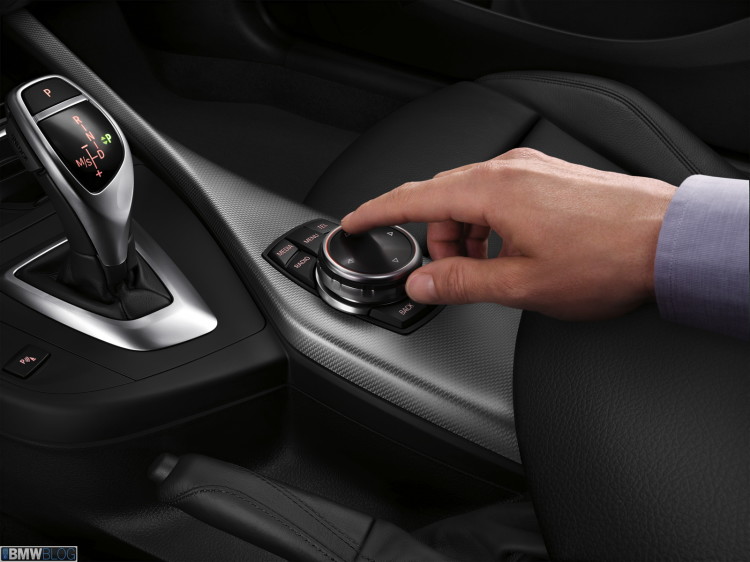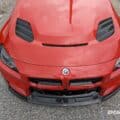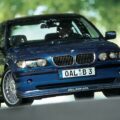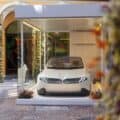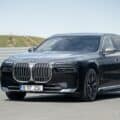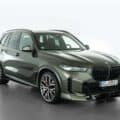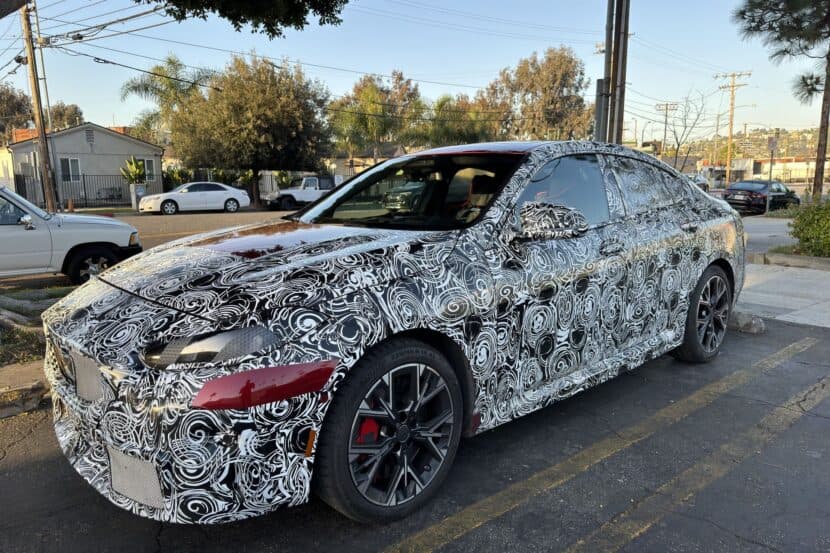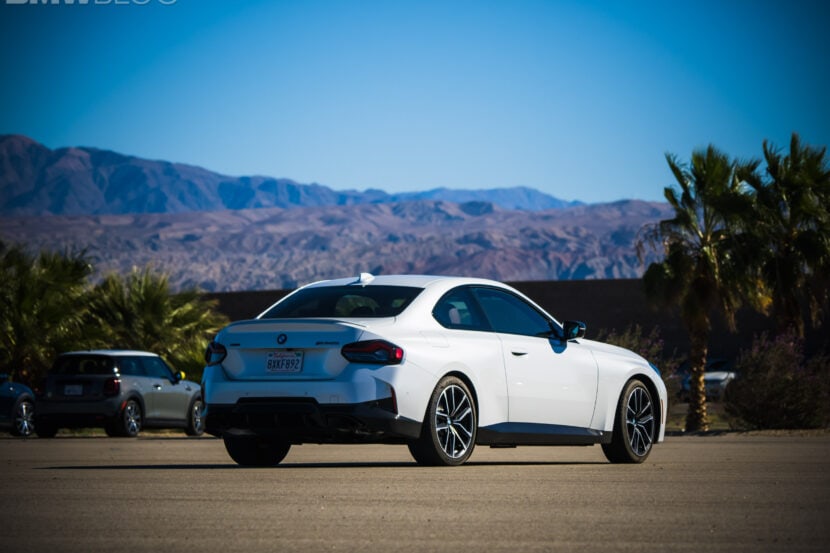BMW 2 Series Coupe will make its world debut at the North American International Auto Show in January 2014. The 2014 BMW 2 Series Coupe will be offered in the U.S. at a Manufacturer’s Suggested Retail Price of $33,025 for the 228i and $44,025 for the M235i, including $925 destination and handling. In Germany, the BMW 220i costs 25,168 Euro, M235i at 36,764 Euro and 220d – 27,310 Euro.
BMW model family celebrates the premiere of another new model series; BMW 2 Series Coupe raises the bar in the premium compact segment in terms of dynamic ability, aesthetic appeal and emotional allure; a distinctive vehicle concept unique in its segment, with a two-door body in classic three-box design typical of BMW Coupes, four seats, rear-wheel drive and an engine range and chassis set-up focused squarely on sporting ability; market launch from March 2014, line-up to include a BMW M Performance Automobile – the BMW M235i Coupe.
BMW 2 Series Coupe given clear visual differentiation from the compact BMW 1 Series models thanks to an individual design, including an 11-centimetre increase in body length; elegantly sporty, stretched lines with roofline flowing smoothly into the rear; distinctive front and rear end design; body at its widest over the rear axle, emphasising the rear-wheel- drive configuration; BMW Sport Line, BMW Modern Line and M Sport package offer scope for individualisation.
- Newly designed Coupe series with significantly larger dimensions than its predecessor, the BMW 1 Series Coupe; length increased by 72 millimetres to 4,432 millimetres, width by 32 millimetres to 1,774 millimetres, wheelbase by 30 millimetres to 2,690 millimetres, front track width by41 millimetres to 1,521 millimetres and rear track width by 43 millimetres to 1,556 millimetres; improved interior space, including 19 millimetres of extra headroom in the front and 21 millimetres of additional legroom in the rear compartment; boot capacity increased by 20 litres to 390 litres; rear seat backrests split into two or, as an option, folding 40 : 20 : 40; optimised aerodynamic details for an improved Cd over both its predecessor and the BMW 1 Series of 0.29 (BMW 220i Coupe).
- Petrol and diesel engines with BMW TwinPower Turbo technology deliver segment-leading figures in terms of both sporting ability and efficiency; BMW 220i Coupe is the first compact BMW model to be powered by the 135 kW/184 hp version of the 2.0-litre four-cylinder petrol engine; four-cylinder diesel engines developing 105 kW/143 hp in the BMW 218d Coupe, 135 kW/184 hp in the BMW 220d Coupe and 160 kW/218 hp in the BMW 225d Coupe; also available to order from launch is the range-topping BMW M235i: the most powerful petrol-drivenBMW M Performance Automobile has a 3.0-litre six-cylinder in-line engine with M Performance TwinPower technology and 240 kW/326 hp, M-specific tuning for chassis components and aerodynamically optimised body features.
- Efficiency increased further by extensive BMW EfficientDynamics technology, including Air Curtains and the Auto Start Stop function in conjunction with both manual and automatic gearbox; ECO PRO mode activated via the standard-fitted Driving Experience Control switch, including coasting function in conjunction with automatic gearbox and including Proactive Driving Assistant if Navigation system Professional is specified.
- Unmistakable BMW handling attributes and impressive ride comfort thanks to rear-wheel drive, longitudinally mounted engines, perfectly balanced distribution of weight and sophisticated chassis technology; double-joint spring strut front axle and five-link rear axle with bespoke tuning; Electric Power Steering and powerful brakes as standard; variable sport steering, M Sport braking system and Adaptive M suspension with electronically controlled dampers optional; DSC stability control system including DTC and an electronic locking function for the rear axle differential as standard; M Performance mechanical limited-slip differential available for the BMW M235i Coupe from launch through the Original BMW Accessories range.
- High-strength and torsionally stiff body structure developed on the basis of the BMW 1 Series, which has been awarded a five-star Euro NCAP crash test rating; extensive occupant protection provided by safety equipment including front, side and head airbags; pedestrian protection optimised by the active bonnet and defined front end deformation zones.
- High-quality interior with driver-focused cockpit; automatic climate control standard; iDrive operating system in conjunction with BMW Professional radio or navigation system including Control Display in exclusive BMW flatscreen design; optional Navigation system Professional including Touch Controller; wide variety of storage compartments, stowage areas and cupholders.
- Selection of optional driver assistance systems and mobility services from BMW ConnectedDrive unparalleled in the compact segment: anti-dazzle High Beam Assistant, Adaptive Headlights, Parking Assistant, rear view camera, Driving Assistant, Speed Limit Info with No Passing Info display, cruise control system with braking function, extended integration ofsmartphones and music players, Real Time Traffic Information, Online Entertainment, extended functionality provided by apps for internet- based services such as Facebook and Twitter.• Model variants:
BMW M235i Coupe: Six-cylinder in-line petrol engine with
M Performance TwinPower Turbo technology (twin-scroll turbochargers, High Precision Direct Injection, VALVETRONIC variable valve timing, Double-Vanos).
Capacity: 2,979 cc, output: 240 kW/326 hp at 5,800 – 6,000 rpm, max. torque: 450 Nm / 332 lb-ft at 1,300 – 4,500 rpm.
Acceleration [0 – 100 km/h / 62 mph]: 5.0 seconds (automatic:4.8 seconds),
top speed: 250 km/h / 155 mph.
Average fuel consumption: 8.1 litres (7.6 litres) per 100 kilometres / 34.9 (37.2) mpg imp,
CO2 emissions: 189 g/km (176 g/km), exhaust standard: EU6.BMW 220i Coupe: Four-cylinder in-line petrol engine with
BMW TwinPower Turbo technology (twin-scroll turbochargers, High Precision Direct Injection, VALVETRONIC variable valve timing, Double-Vanos.
Capacity: 1,997 cc, output: 135 kW/184 hp at 5,000 – 6,250 rpm, max. torque: 270 Nm / 199 lb-ft at 1,250 – 4,500 rpm.
Acceleration [0 – 100 km/h / 62 mph]: 7.0 seconds (automatic: 7.0 seconds),
top speed: 235 km/h / 146 mph (230 km/h / 143 mph).
Average fuel consumption*: 6.1 – 6.3 litres (5.7 – 6.0 litres) per 100 kilometres / 46.3 – 44.8 (49.6 – 47.1) mpg imp,
CO2 emissions*: 142 – 148 g/km (134 – 139 g/km), exhaust standard: EU6.BMW 225d Coupe: Four-cylinder in-line diesel engine with
BMW TwinPower Turbo technology (two turbochargers, multi-stage turbocharging, common rail direct injection with piezo injectors, max. injection pressure: 2,000 bar).
Capacity: 1,995 cc, output: 160 kW/218 hp at 4,400 rpm, max. torque: 450 Nm / 332 lb-ft at 1,500 – 2,500 rpm,
Acceleration automatic [0 – 100 km/h / 62 mph]: 6.3 seconds,
top speed: 242 km/h / 150 mph.
Average fuel consumption*: 4.7 litres per 100 kilometres / 60.1 mpg imp, CO2 emissions*: 124 g/km, exhaust standard: EU6 (provisional figures). - BMW 220d Coupe: Four-cylinder in-line diesel engine with
BMW TwinPower Turbo technology (turbochargers with variable inlet geometry, common rail direct injection with solenoid valve injectors, max. injection pressure: 1,800 bar).
Capacity: 1,995 cc, output: 135 kW/184 hp at 4,000 rpm,
max. torque: 380 Nm / 280 lb-ft at 1,750 – 2,750 rpm.
Acceleration [0 – 100 km/h / 62 mph]: 7.2 seconds (automatic: 7.1 seconds),
top speed: 230 km/h / 143 mph (230 km/h / 143 mph), average fuel consumption*: 4.5 – 4.8 litres (4.2 – 4.4 litres) per 100 kilometres / 62.8 – 58.9 (67.3 – 64.2) mpg imp,
CO2 emissions*: 119 – 125 g/km (111 – 117 g/km), exhaust standard: EU6. - BMW 218d Coupe: Four-cylinder in-line diesel engine with
BMW TwinPower Turbo technology (turbochargers with variable inlet geometry, common rail direct injection with solenoid valve injectors, max. injection pressure: 1,600 bar).
Capacity: 1,995 cc, output: 105 kW/143 hp at 4,000 rpm, max. torque: 320 Nm / 236 lb-ft at 1,750 – 2,500 rpm.
Acceleration [0 – 100 km/h / 62 mph]: 8.9 seconds (automatic: 8.6 seconds),
top speed: 213 km/h / 132 mph (213 km/h / 132 mph).
Average fuel consumption*: 4.3 – 4.5 litres (4.2 – 4.4 litres) per 100 kilometres / 64.9 – 62.8 (67.3 – 64.2) mpg imp,
CO2 emissions*: 114 – 119 g/km (111 – 117 g/km), exhaust standard: EU6.* Figures according to EU test cycle, may vary depending on the tyre format specified.
BMW 225d Coupe and BMW 218d Coupe: all performance, fuel consumption and emissions figures are provisional.
The concept:Driving pleasure times 2.
- Unbeatable driving dynamics in the premium compact segment.
- Emotionally appealing aesthetics in typical BMW Coupe style.
- Sporting tradition dates back to the BMW 02 range.
This is not the first time that BMW has treated the compact segment to its customary brand of driving pleasure. The BMW 1 Series, for example, has fulfilled this role for almost 10 years now, its standout position among its rivals rooted most prominently in its rear-wheel-drive concept (still a unique proposition in this class), powerful engines with BMW TwinPower Turbo technology and a compelling premium character. And now the BMW 2 Series Coupe takes the levels of driving pleasure on offer in a compact model to even greater heights. The new two-door cuts a particularly impressive figure with its distinctive body design, a range of extremely powerful engines and specially configured chassis technology.
There is clear water between the BMW 2 Series Coupe and the BMW 1 Series, the new model assuming a character all of its own. This differentiation is immediately recognisable in the design of the new car, but it also makes its presence felt in terms of performance. The BMW 2 Series Coupe is an even more eye-catching creation than its predecessor, the resoundingly successful BMW 1 Series Coupe (of which more than 150,000 units have been sold worldwide). As well as a standalone appearance and increased dimensions, there is also greater depth to its product substance in terms of both technology and standard equipment. The result is a new dimension in driving dynamics, aesthetic appeal and premium allure in the compact segment, highlighted by the “2” in the new car’s model designation. The number 2 has denoted the presence of a supremely sporting driving experience in a compact two-door car for over 45 years – ever since the introduction of the BMW 02 range.
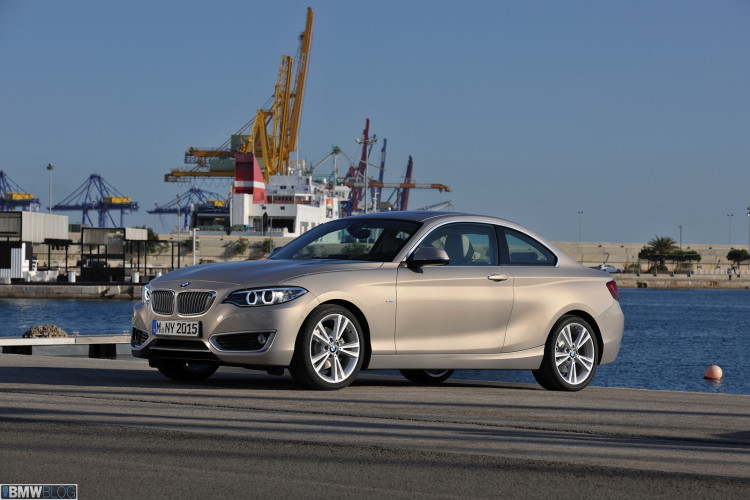
Characteristic features of a BMW Coupe.
The specific vehicle concept behind the BMW 2 Series Coupe – unique in its segment – is faithfully reflected in its body design. The two-door model is first and foremost a Coupe from the BMW brand, and the design features that identify a member of this special breed – a three-box body with clearly defined boot and low-slung silhouette, a long bonnet, doors with frameless windows and a dynamically stretched roofline flowing smoothly into the rear end – are carried over into a compact model with greater enthusiasm and intent than ever. The ultra-sporty driving characteristics of the BMW 2 Series Coupe – generated by a hand-picked selection of engines and chassis technology tuned to make the perfect pairing – are thus unambiguously expressed in the design of the exterior. The 135 kW/184 hp four-cylinder engine in the BMW 220i Coupe is making its debut in a compact BMW model, and the 240 kW/326 hp six-cylinder in-line engine under the bonnet of the BMW M235i Coupe earns it top billing as the most powerful petrol-driven member of the BMW M Performance Automobile line-up.
The specific proportions of the BMW 2 Series Coupe are contained within a body measuring 4,432 millimetres in length. The two-door model is therefore 108 millimetres longer than the BMW 1 Series and 72 millimetres longer than the outgoing BMW 1 Series Coupe. The new compact Coupe is also 32 millimetres wider than its predecessor (at 1,774 millimetres), and has a 30-millimetre longer wheelbase (2,690 millimetres) and wider tracks (front: 1,521 millimetres, +41 millimetres; rear: 1,556 millimetres, +43 millimetres). At the same time the vehicle height has been lowered by 5 millimetres to 1,418 millimetres. The result is an increase in interior space and 20 litres of extra boot capacity (now 390 litres). Added to which, the BMW 2 Series Coupe also boasts more efficient aerodynamics than both the BMW 1 Series and its predecessor, as reflected in a Cd of 0.29 for the BMW 220i Coupe.
Sporting tradition on a compact footprint.
The BMW 2 Series Coupe builds on the brand’s tradition of compact models offering a satisfying degree of driver engagement. And the presence of the 2 in the model designation creates a close link to this heritage. The introduction in 1966 of the BMW 1600-2, for instance, opened up a whole new vehicle segment. Inspired most profoundly by its precisely tailored package of powertrain and chassis technology, the two-door Coupe became a global standard-bearer for sporty handling and intense driving pleasure in the compact car segment. Additional engine variants increased the appeal of the new model series. For example, the BMW 2002 presented in 1968 took centre stage – in terms of both popularity and its success in turning “Freude am Fahren” (Sheer Driving Pleasure) from a slogan into an experience for whole new target groups. The most spectacular variant was the 125 kW/170 hp BMW 2002 turbo – the first model from a European manufacturer to gain the services of a turbocharger.
The design: Strong character cuts a distinctive figure.
- Typical Coupe proportions, dynamic lines, powerful forms.
- Bespoke front and rear detailing accentuates the car’s sporting profile.
- BMW Sport Line and BMW Modern Line create scope for individualisation.
An instantly beguiling blend of sporting prowess and elegance marks out the design of BMW Coupes. And the exterior features which are such a key element of this identity have been carried over to the compact segment car with greater purpose than ever for the BMW 2 Series Coupe. The proportions, lines and surface design of the car have all been tailored to accentuate both the agile driving properties of the two-door and its unique appearance. The BMW 2 Series Coupe has its own specific design language, which secures it a stand-out position in the brand’s model range and – most importantly – sets it apart unmistakably from its segment rivals.
Sporting presence, muscular agility and assured elegance come together in the exterior design of the BMW 2 Series Coupe. Defining elements of its interior, meanwhile, include the driver-focused cockpit design you expect of a BMW and a light and contemporary brand of functionality. The car’s more clearly distinguished design identity illustrates its progress in moving the game on from its predecessor. The BMW 2 Series Coupe embodies Sheer Driving Pleasure in more concentrated and intense form than ever before in the premium compact segment.
Classical BMW features and a fresh interpretation of traditional Coupe elements.
The individual vehicle concept of the BMW 2 Series Coupe is underlined by its specific front and rear end design, dynamically stretched lines and an almost 11-centimetre increase in body length over the BMW 1 Series. Characteristic design elements of a BMW Coupe have been carried over into the compact segment and signature brand features given a fresh twist.
Another stand-out feature of BMW Coupes – the hallmark three-box body structure with a clear distinction between roofline and boot – has a particularly clear presence in the new compact model. Like the side swage lines that wrap around into the rear end, this feature picks up on characteristic styling elements of the BMW 02, drawing a link between the new car and the brand’s long tradition of sporting and agile compact models.
Lines tapering down dynamically towards the BMW kidney grille lend the front end of the BMW 2 Series Coupe a forward-surging presence. The modified contours of the headlight units narrow at their inner extremes, while a standard accent strip – or, if the optional bi-xenon lights are fitted, an LED accent light – cuts across the top of the hallmark BMW twin circular lights. The BMW kidney grille, which is separated from the headlights by narrow strips on either side, protrudes clearly from the front of the car and slants forward at a slight angle. The three-dimensional design of the grille surround and its 11 vertical bars reinforce the car’s striking appearance. The lower air intake is split into three sections. The two outer elements are particularly large and their outlines replicate the form of the headlight units. Air Curtains are integrated harmoniously into an additional section at the outer edges of the front apron and channel the onrushing air precisely behind the front side panels, causing it to hang over the wheels like a curtain. This reduces turbulence and further enhances the outstanding aerodynamics of the BMW 2 Series Coupe.
The side view of the BMW 2 Series Coupe sees signature brand features like a long bonnet, short overhangs, set-back passenger compartment, Hofmeister kink (the counter-swing in the window frame at the trailing edge of the C-pillars) and door openers integrated into the swage line blending with coupe-specific design elements, chief among them the slim window graphic and sweeping roofline gliding back smoothly into the rear end. A prominent character line above the door sill sweeps up rearwards of the B-pillar into the rear wheel arch, whose powerfully flared form focuses the mind on the car’s rear-wheel drive and swells the BMW 2 Series Coupe’s body to its broadest point. The dynamic wedge shape of the two-door model is emphasised, too, by the door sill line itself, which likewise rises up towards the rear. The
BMW 2 Series Coupe also has doors with frameless windows and turn signal indicators integrated into the exterior mirrors.
The rear of the BMW 2 Series Coupe is a broad and powerful affair, an impression reinforced by the single-piece light units reaching far into the car’s flanks in the L-shape familiar from other BMW models. An unmistakable night design is provided by the likewise L-shaped LED rear light strips within the units. The third brake light positioned at the upper edge of the rear window is also fed by LED units.
The lines along the sides of the boot lid taper downwards slightly. This styling cue, along with the additional crease and suggested diffuser element in the rear apron, accentuates the BMW 2 Series Coupe’s road focus and low centre of gravity. And yet the new car also has a wider boot aperture than its predecessor.
The exterior paintwork of the BMW 2 Series Coupe can be ordered in a choice of two non-metallic and 10 metallic shades, while customers can also specify Estoril Blue metallic as part of the M Sport package.
Interior: cockpit design ensures maximum driving pleasure; premium ambience can be enjoyed from four seats.
The dominant themes of the BMW 2 Series Coupe’s interior are the driver- focused design of the cockpit, contemporary functionality and high-quality materials. An Easy Entry function for the front seats facilitates access to the two rear seats, which offer 21 millimetres more legroom than the outgoing Coupe, while headroom for the driver and front passenger has grown by a similar extent. Functionality levels are raised another notch by features including large storage compartments in the doors. The structure of the surfaces for the instrument panel, centre console and door trim is dominated by the “layering” effect created by various overlapping surfaces. The length of the doors is emphasised by the converging lines of the door trim elements.
If the BMW 2 Series Coupe is fitted with an optional navigation system or the BMW Professional radio, it will also feature the BMW iDrive operating system, which includes a freestanding onboard monitor in flatscreen design. The Control Display comes in 6.5 or 8.8-inch form, depending on the version specified, while the Controller on the centre console has a touch-sensitive surface which allows the driver to input characters (if the Navigation system Professional is fitted).
Dakota leather trim is available as an alternative to the standard cloth seat surfaces in a choice of three colours. The interior trim strips come in matt Satin Silver as standard but are also optionally available in brushed aluminium or Fineline Stream exquisite wood.
Serving the cause of individual style: BMW Sport Line, BMW Modern Line and the M Sport package.
The BMW Lines – available as an alternative to standard specification for the BMW 2 Series Coupe – offer harmoniously coordinated exterior and interior design and equipment features. Both the BMW Sport Line and BMW Modern Line include 17-inch light-alloy wheels in exclusive designs, ambient lighting with variable use of colours and special seat upholstery, interior trim strip and car key designs. BMW Sport Line brings a high-gloss black finish for the outer air intake surrounds, the front of the kidney grille bars, the cross rib in the centre air intake and the rear apron, emphasising the dynamic credentials of the two-door newcomer. And BMW Modern Line serves the cause of progressive elegance through the use of matt aluminium for the design elements mentioned above and a body-coloured paint finish for the cross rib in the centre air intake.
Also available from the launch of the BMW 2 Series Coupe is the M Sport package developed specially for the new model. This option comprises bespoke suspension tuning (including a 10-millimetre drop in ride height and 17-inch M light-alloy wheels in double-spoke design), aerodynamically optimised body elements (including large front air intakes, striking side skirts and a diffuser for the rear apron), plus a special design for the BMW kidney grille and an exhaust tailpipe embellisher in high-gloss chrome. In addition to aluminium door sill strips bearing the M logo, features such as sports seats for the driver and front passenger, Aluminium Hexagon interior trim strips with an accent strip in Estoril Blue, a special dial design for the instrument cluster, ambient lighting and an M driver’s footrest also combine to bring an intense aura of sporty driving to the interior of the BMW 2 Series Coupe.
The driving experience: A perfect balance of agility, efficiency and comfort.
- Petrol and diesel engines with BMW TwinPower technology.
- Unique in its segment: the eight-speed automatic gearbox.
- Driving Experience Control switch as standard, variable sport steering, M Sport braking system and Adaptive M suspension on the options list.
BMW TwinPower Turbo technology ensures an unbeatable balance between driving pleasure and fuel economy in both the petrol and the diesel engines available from launch for the BMW 2 Series Coupe. Output is up by as much as 10 kW over the new car’s predecessor, yet average fuel consumption in the EU test cycle has dropped by up to 21 per cent, depending on the model. The specially assembled engine line-up for the BMW 2 Series Coupe, the advanced chassis technology tuned precisely to the engine output on offer and the rear-wheel-drive configuration unique in its segment provide a sporty driving experience beyond the reach of any rival, combined with outstanding comfort. Added to which, the standard Driving Experience Control switch gives drivers the option – at the touch of a button – of adjusting the car’s set-up to their individual preferences or the driving situation at hand.
One four-cylinder petrol engine and one four-cylinder diesel unit are available from launch, putting 135 kW/184 hp at the disposal of the BMW 220i Coupe and BMW 220d Coupe. Joining them centre stage, with a six-cylinder in-line engine developing 240 kW/326 hp, is the BMW M235i Coupe (see chapter 5). And following hot on the heels of that trio are two more four-cylinder diesel models in the form of the BMW 218d Coupe (105 kW/143 hp) and
BMW 225d Coupe (160 kW/218 hp). All the engines can be combined with an eight-speed automatic gearbox (standard in the BMW 225d Coupe) for fuel consumption and emissions figures that are even lower than those achieved with the standard six-speed manual gearbox. All model variants come with extensive BMW EfficientDynamics technology as standard and meet the stipulations of the EU6 exhaust standard.
BMW 220i Coupe: efficient power from 2.0-litre displacement.
The engine powering the BMW 220i Coupe sources significantly higher output from its 2.0-litre displacement than the four-cylinder petrol units available for the BMW 1 Series range. The driver can rely on the services of 135 kW/184 hp between 5,000 and 6,250 rpm and peak torque of 270 Newton metres (199 lb-ft), which is on tap between 1,250 and 4,500 rpm. The engine makes for a compelling proposition thanks to a familiar BMW appetite for revs, an impressive level of efficiency and – courtesy of a modified piston construction – optimised acoustic properties. Its BMW TwinPower Turbo technology package comprises a twin-scroll turbocharging system, High Precision Direct Injection, VALVETRONIC fully variable valve timing and Double-Vanos variable camshaft control.
The BMW 220i Coupe sprints from 0 to 100 km/h / 62 mph in 7.0 seconds on the way to a top speed of 235 km/h / 146 mph (automatic: 230 km/h /
143 mph). The average fuel consumption of the BMW 220i Coupe stands at between 6.1 and 6.3 litres per 100 kilometres / 46.3 – 44.8 mpg imp (automatic: 5.7 – 6.0 litres / 49.6 – 47.1 mpg imp), while its CO2 emissions come in at between 142 and 148 grams per kilometre (134 – 139 g/km; figures are calculated according to the EU test cycle and may vary depending on the tyre format specified). As these figures confirm, the BMW 220i Coupe’s 10 kW increase in output over its predecessor has been complemented by a drop in fuel consumption of up to 14 per cent.
BMW 220d Coupe: high on torque, low in emissions.
A turbocharger with variable inlet geometry and common rail direct injection, whose solenoid valve injectors employ maximum pressure of 1,800 bar, are the key features of the BMW TwinPower Turbo engine technology in the BMW 220d Coupe. This enables the 2.0-litre four-cylinder diesel engine to match instantaneous pulling power with extremely efficient combustion. Maximum output of 135 kW/184 hp is available at 4,000 rpm and peak torque of 380 Newton metres (280 lb-ft) comes on stream between 1,750 and 2,750 rpm.
Fitted with the standard manual gearbox, the BMW 220d Coupe dashes from 0 to 100 km/h / 62 mph in 7.2 seconds (7.1 seconds with the optional automatic). Top speed stands at 230 km/h / 143 mph with either gearbox. The output of the BMW 220d Coupe is 5 kW higher than that of its predecessor, yet it records even lower fuel consumption and emissions. Average fuel economy stands at 4.5 – 4.8 litres per 100 kilometres / 62.8 – 58.9 mpg imp (automatic: 4.2 – 4.4 litres / 67.3 – 64.2 mpg imp), CO2 emissions are 119–125 grams per kilometre (111 – 117 g/km; figures are calculated according to the EU test cycle and may vary depending on the tyre format specified). Cars fitted with the optional eight-speed automatic gearbox achieve the largest reduction in fuel consumption, of around 21 per cent.
Customers can order their BMW 220d Coupe from launch with a BMW M Performance Power Kit from the Original BMW Accessories range. This kit lifts engine output by 12 KW and increases peak torque by 20 Newton metres (15 lb-ft). Fuel consumption and emissions are unaffected by the resultant improvement in sprinting performance.
BMW 218d Coupe: economical diesel entry model.
Further additions to the engine line-up include another two 2.0-litre four- cylinder diesel units with BMW TwinPower Turbo technology. A turbocharger with variable geometry and common rail direct injection, whose solenoid valve injectors fire fuel into the combustion chambers at up to 1,600 bar, endow the engine in the BMW 218d Coupe with peak output of 105 kW/143 hp and maximum torque of 320 Newton metres (236 lb-ft). The entry-level diesel model needs 8.9 seconds (automatic: 8.6 seconds) to accelerate from 0 to 100 km/h / 62 mph en route to a top speed of 213 km/h / 132 mph (213 km/h / 132 mph). The BMW 218d Coupe posts average fuel consumption of 4.3 – 4.5 litres
(4.2 – 4.4 litres) per 100 kilometres / 64.9 – 62.8 (67.3 – 64.2) mpg imp and CO2 emissions of 114 – 119 grams per kilometre (111 – 117 g/km; all data are provisional, fuel consumption and emission figures are calculated according to the EU test cycle and may vary depending on the tyre format specified).
BMW 225d Coupe: sporty and efficient thanks to multi-stage turbocharging.
Serving up output of 160 kW/218 hp and peak torque of 450 Newton metres (332 lb-ft), the engine in the BMW 225d Coupe is the most powerful diesel variant available for the new two-door model. Its two-stage turbocharging system consists of one large and one small turbocharger, also with variable geometry, whose precisely controlled interplay ensures instantaneous pulling power. The piezo injectors of its common rail direct injection system generate maximum pressure of 2,000 bar. The BMW 225d Coupe is fitted as standard with the eight-speed automatic gearbox and sprints from a standstill to 100 km/h / 62 mph in 6.3 seconds. Top speed is 242 km/h / 150 mph. With average fuel consumption of 4.7 litres per 100 kilometres / 60.1 mpg imp and CO2 emissions of 124 grams per kilometre, the sportiest diesel model in the line-up also achieves outstanding efficiency (all data are provisional, fuel consumption and emission figures are calculated according to the EU test cycle).
Sports automatic with Launch Control, ECO PRO mode with coasting function.
As well as the eight-speed automatic gearbox, the BMW 2 Series Coupe can also be ordered as an option with a Sports automatic, which uses ultra-fast gear changes to underline the dynamic character of the two-door car. This gearbox variant likewise comes with gearshift paddles on the steering wheel and a Launch Control function (not available for 218d), which enables traction- optimised, dynamically maximised acceleration off the line. All the 0 to 100 km/h / 62 mph acceleration figures for the automatic variants of the BMW 2 Series Coupe were recorded using Launch Control.
The standard-fitted Driving Experience Control switch on the centre console allows the car’s set-up to be adjusted at the touch of a button through COMFORT, SPORT and ECO PRO settings. SPORT+ mode is also available for cars equipped with at least one of the following options: Sports automatic gearbox, M Sport package, BMW Sport Line, Adaptive M suspension or variable sport steering. The Driving Experience Control switch can also be used to modify the car’s accelerator mapping and steering characteristics as well as – depending on specification – the responses of the automatic gearbox and dampers.
In ECO PRO mode the car encourages a particularly relaxed as well as frugal driving style. And BMW 2 Series Coupe drivers also reap the benefits of the latest addition to the fuel-saving arsenal – the coasting function, available in conjunction with an automatic gearbox. At speeds between 50 and 160 km/h (approx. 30 and 100 mph), the powertrain is disengaged as soon as the driver takes his or her foot off the accelerator. If the Navigation system Professional is specified, drivers also enjoy the services of the Proactive Driving Assistant. In ECO PRO mode this system alerts drivers to the ideal fuel-saving moment to take their foot off the gas ahead of corners, junctions, roundabouts and speed-restricted areas.
The standard-fitted BMW EfficientDynamics technology also includes Brake Energy Regeneration, on-demand operation of ancillary units, Electric Power Steering, an Optimum Shift Indicator and the Auto Start Stop function, which can also be used in conjunction with an automatic gearbox.
Advanced chassis technology tuned precisely to the engine’s output.
The advanced chassis engineering of the BMW 2 Series Coupe includes elements such as a double-joint spring strut front axle with suspension struts and anti-roll bars, and a five-link rear axle. The chassis has a large aluminium content and has been adapted specially to suit the output of the engine fitted. This allows the driver to fully exploit the dynamic potential of the new Coupe, to which a low centre of gravity, a much wider track compared to its predecessor and ideal 50 : 50 weight distribution make key contributions. The Electric Power Steering system is as impressively energy efficient as it is accurate and, like the powerful brakes, enhances the car’s precise handling characteristics. This creates an eye-catching and harmonious blend of sporting agility and ride comfort in everyday driving.
Variety of options to tailor the car’s handling to personal preference: Servotronic, variable sport steering, M Sport braking system, Adaptive M suspension, M Sport suspension.
A wealth of different options allow the handling characteristics of the BMW 2 Series Coupe to be adapted precisely to individual preferences. As well as Servotronic speed-sensitive power assistance for the steering, customers can also specify variable sport steering, which employs a variable ratio for the steering rack to reduce the steering movement required to achieve large degrees of wheel turn. Parking and turning-off manoeuvres are completed safely and comfortably with little steering effort. And at higher speeds drivers can also look forward to the steering precision and straightline stability for which BMW is renowned.
If the M Sport package is specified, customers can also order their car with the M Sport braking system with fixed callipers, four pistons at the front wheels and two pistons at the rear, and particularly large brake discs. The callipers are painted dark blue and carry the M logo. Another item available from the Original BMW Accessories range is the BMW M Performance braking system with even larger, perforated and riveted discs and callipers painted in either red, orange or yellow.
The selection of optional equipment includes Adaptive M suspension with electronically controlled dampers and M Sport suspension with extra-stiff spring and damper settings. Both set-ups come with a 10-millimetre reduction in ride height. The BMW M Performance sports suspension (also available from the Accessories range) goes a step further still, offering customers a 20-millimetre drop in ride height, bespoke dampers and shorter, red-painted coil springs for their BMW 2 Series Coupe from launch.
The standard-fitted DSC (Dynamic Stability Control) system comes complete with the Anti-lock Braking System (ABS), DTC (Dynamic Traction Control), Cornering Brake Control (CBC) and Dynamic Brake Control (DBC). These tools are complemented by Brake Assist, Fading Compensation, the Brake Drying function and Start-Off Assistant. In DTC mode, the response thresholds of the driving stability system are set at a higher level. This allows the driver to make use of controlled slip through the driven wheels to pull away on snow or loose surfaces and when taking a particularly dynamic approach to cornering. In DSC Off mode, the Active Differential Brake (ADB- Sport) on the rear axle is activated. Here, a carefully calculated degree of braking force is applied to a spinning driven wheel under acceleration through tight bends, so that drive can still be channelled through the other wheel on the axle and traction levels optimised.
The BMW 225d Coupe is fitted with 17-inch light-alloy wheels as standard. All other model variants will roll off the assembly line on 16-inch light-alloy wheels. The options list also contains additional 17 and 18-inch light-alloy wheel variants, while 19-inch BMW M Performance forged light-alloy wheels can be specified via the Accessories range.
Body, safety and equipment: Intelligent lightweight design, smart details
- Spaciousness and functionality much enhanced compared to predecessor model.
- Comprehensive safety concept including pedestrian protection.
- Extensive standard equipment and high-quality options help to set models apart.
The development of the BMW 2 Series Coupe has seen significant progress made in terms of spaciousness, functionality and occupant protection compared with its predecessor. The new car’s larger dimensions benefit both interior space and boot capacity. At the same time, even higher standards of passive safety have been achieved thanks to optimized material selection and innovative body construction technology, while weight has been minimized. The BMW 2 Series Coupe also includes a number of innovative pedestrian protection measures.
Its broader spread of standard equipment is another aspect of the new model that clearly sets it apart from the BMW 1 Series. And the BMW 2 Series Coupe can also be specified with a host of high-quality options that underline its premium character.
Intelligent lightweight design optimizes agility and safety.
The construction techniques and materials used for the body of the BMW 2 Series Coupe are underpinned by the principle of intelligent lightweight design. This approach allows agility and occupant protection to be enhanced while keeping the car’s weight as low as possible.
For example, the increased rigidity of the car’s front end has a direct effect on the dynamic properties of the BMW 2 Series Coupe.
Measures such as considered use of high and ultra-high-tensile steels lend the body increased torsional stiffness and ensure the strength of the safety passenger cell. The mean strength of the materials used in the new Coupe is 13 percent higher than was the case in its predecessor.
All-embracing concept for occupant and pedestrian protection.
The precise interplay of numerous safety components as part of a far- reaching overall concept guarantees an impressively high level of occupant protection in situations where a collision is unavoidable. This means the BMW 2 Series Coupe has everything it needs to achieve outstanding ratings in all the relevant crash tests around the world.
Extremely durable supporting structures, large deformation zones and highly efficient restraint systems coordinated by powerful control electronics form the basis for the high standard of passive safety in the new BMW 2 Series Coupe. The forces generated in a collision are diverted via precisely defined load paths, absorbed in the deformation zones and thus kept away from the extremely rigid passenger cell. In addition, further developed load path design optimizes compatibility when it comes to minimizing the consequences of accidents for other vehicles involved.
Wide-ranging measures have been implemented in the development of the BMW 2 Series Coupe as far as pedestrian protection is concerned. Relocating the intake air duct for the engine plus the air filter for the interior allowed the creation of a larger deformation zone in the hood area. The BMW 2 Series Coupe has also been designed with an “active” hood system: in the event of a collision with a pedestrian or cyclist, the system automatically raises the rear part of the bonnet. This creates additional deformation capacity, and the risk of injury in a collision with particularly unyielding sections of the engine is reduced.
The standard safety equipment in the BMW 2 Series Coupe includes front airbags, side airbags integrated into the seat backrests, head airbags for the front and rear seats as well as knee airbags for the driver and front passenger. Three-point inertia-reel seatbelts for all seats, belt force limiters and belt tensioners in the front, and ISOFIX child seat attachments in the rear are also included. The standard Tire Pressure Monitor registers a loss of pressure in individual tires and warns the driver by activating a signal in the instrument cluster.
Comfortable entry and more rear legroom.
The BMW 2 Series Coupe is significantly larger than its predecessor in terms of exterior length, width, wheelbase and track width. These increased dimensions are evident in areas such as headroom in the front seats, which has grown by 0.7 inches (19 mm), and rear-seat legroom, which is up by 0.8 inches (21 mm). In addition, the access space through to the rear is now 0.4 inches (11 mm) larger which, when combined with the standard Easy Entry function for the front seats, means that using the rear seats is a more comfortable experience.
The luggage compartment of the BMW 2 Series Coupe has grown by 0.7 cu.ft. (20 liters) and now offers 13.8 cu.ft. (390 liters) of capacity. The width of the trunk aperture is 1.5 inches (38 mm) greater than that offered by the outgoing Coupe. The standard 60:40 split/folding rear seat bench ensures additional variability when it comes to making maximum use of the car’s load-carrying potential. With large door pockets, a roomy glove compartment, two cup holders in the center console and a storage compartment under the armrest, the BMW 2 Series Coupe also offers increased stowage capacity inside the passenger compartment. The lower section of the door trim offers space for drinks bottles up to one liter in size.
Standard equipment includes dual-zone automatic climate control and Driving Experience Control.
The standard equipment list for the BMW 2 Series Coupe starts with the iDrive Controller and screen as well as Bluetooth hands-free and USB port. Standard equipment for the BMW 2 Series Coupe also includes Driving Experience Control – which allows the driver to adjust the suspension set-up as desired – and dual zone automatic climate control.
With the optional Navigation system on board, iDrive brings with it an 8.8-inch Control Display and a Touch Controller with touch-sensitive surface which allows the driver to input characters. Among the equipment available to fulfill individual communication and entertainment requirements are Bluetooth audio streaming and the Harman Kardon HiFi system.
BMW ConnectedDrive in the BMW 2 Series Coupe: Connectivity with added variety
- Most extensive range of driver assistance systems and mobility services in the sub-compact segment.
- High Beam Assistant and A c t i v e Driving Assistant enhance safety.
- Standard BMW Assist eCall with enhanced automatic collision notification and BMW Teleservice included for 10 years.
- Additional functions can be accessed through BMW ConnectedDrive.
The range of standard and optional equipment available via BMW ConnectedDrive ensures the BMW 2 Series Coupe occupies a leading position when it comes to the intelligent link-up of the driver, car and outside world. BMW ConnectedDrive offers a selection of innovative driver assistance systems and mobility services designed to optimize comfort, safety and the use of infotainment functions. Among the driver assistance systems available for the first time in a sub-compact model from BMW are the High Beam Assistant and optional Active Driving Assistant. The optional ConnectedDrive Services provide an optimized platform for using telephone and internet- based services, while a range of other innovative functions can be integrated into the car’s operating system via apps.
Driver assistance systems enhance comfort and safety.
The range of BMW ConnectedDrive features available for the BMW 2 Series Coupe includes a rain sensor with automatic headlight activation. Adaptive Xenon headlights including cornering light are optional. Customers can also order their car with High Beam Assistant.
Other features available for the BMW 2 Series Coupe include Park Distance Control and the rear view camera, which displays its images on the iDrive operating system’s Control Display in order to help to ensure precise and comfortable maneuvering. The likewise optional Parking Assistant aids the driver in choosing and making use of parallel parking spaces. The system identifies suitable spaces and, if desired, carries out the steering movements required to park the car.
The innovative Driving Assistant option comprises the camera-based Lane Departure Warning and Collision Warning systems. The Lane Departure Warning system can be used at speeds over 70 km/h (43 mph) and alerts drivers with a visible signal in the instrument cluster and a vibration though the steering wheel rim if they have inadvertently drifted out of their lane. At speeds upwards of 15 km/h (9 mph), Collision Warning recognizes if the distance to the vehicle travelling in front has become too small. As well as triggering visual and acoustic warnings, this system primes the brakes to help the driver achieve the shortest possible stopping distance if he or she has to intervene.
Internet-based services can be integrated into the car via apps.
Innovative technologies also optimize the integration of the Apple iPhone and other smartphones, as well as music players, into the car, including the use of internet-based services. The ConnectedDrive Services option lays the groundwork for in-car connectivity by means of a built-in SIM card. This allows customers to access the internet, the Concierge Service telephone-based information facility, remote functions, the BMW ConnectedDrive range of online entertainment features. BMW Assist eCall with enhanced automatic collision notification and BMW TeleService is included for 10 years as standard equipment on every BMW 2 Series in the US.
Numerous other functions can also be integrated into the car at a later stage using apps – via a smartphone or the built-in SIM card. These include Advanced Real Time Traffic Information, web radio functions and use of social networking services such as Facebook and Twitter. The flexible app concept allows the integration both of applications developed by the BMW Group and of BMW Apps-ready applications from external providers. One app that is tailor-made for a car like the M235i is the M Laptimer. Looking forward, this capability will allow BMW drivers to seamlessly transfer numerous familiar functions into their car.




